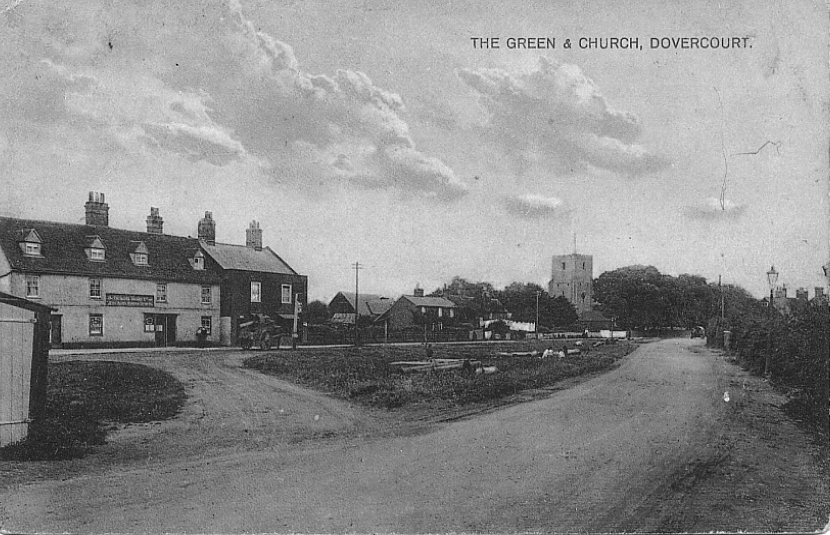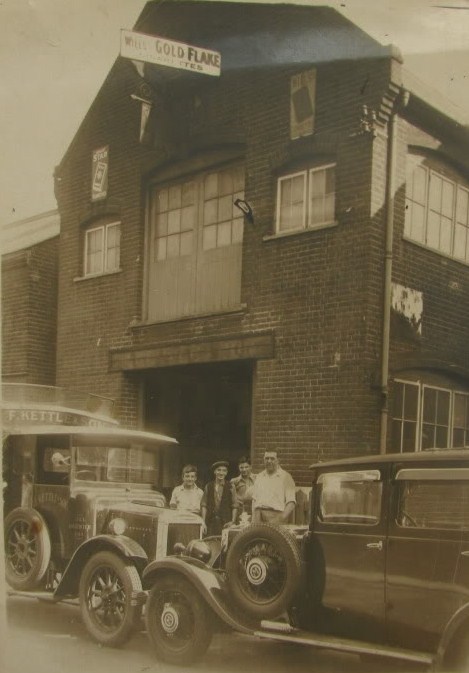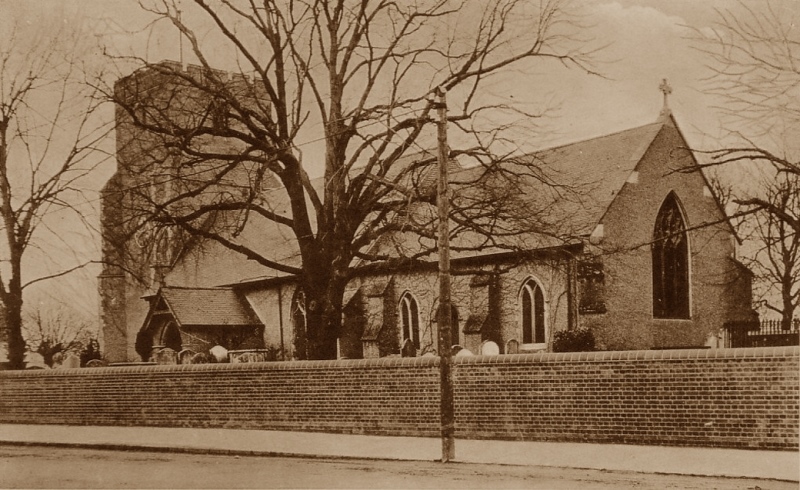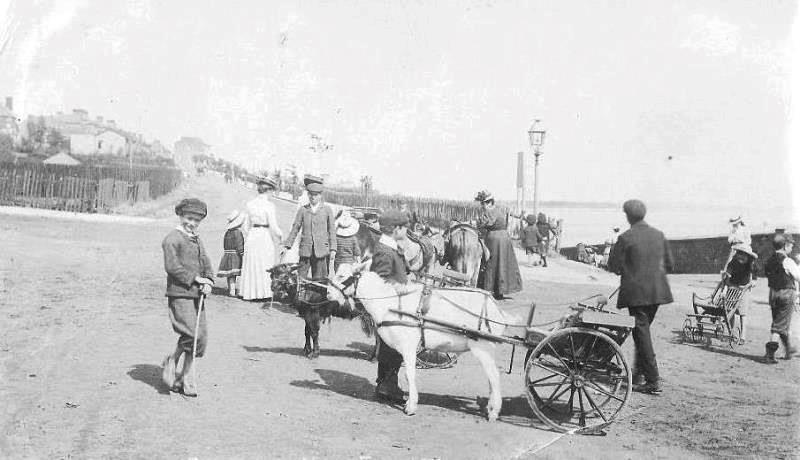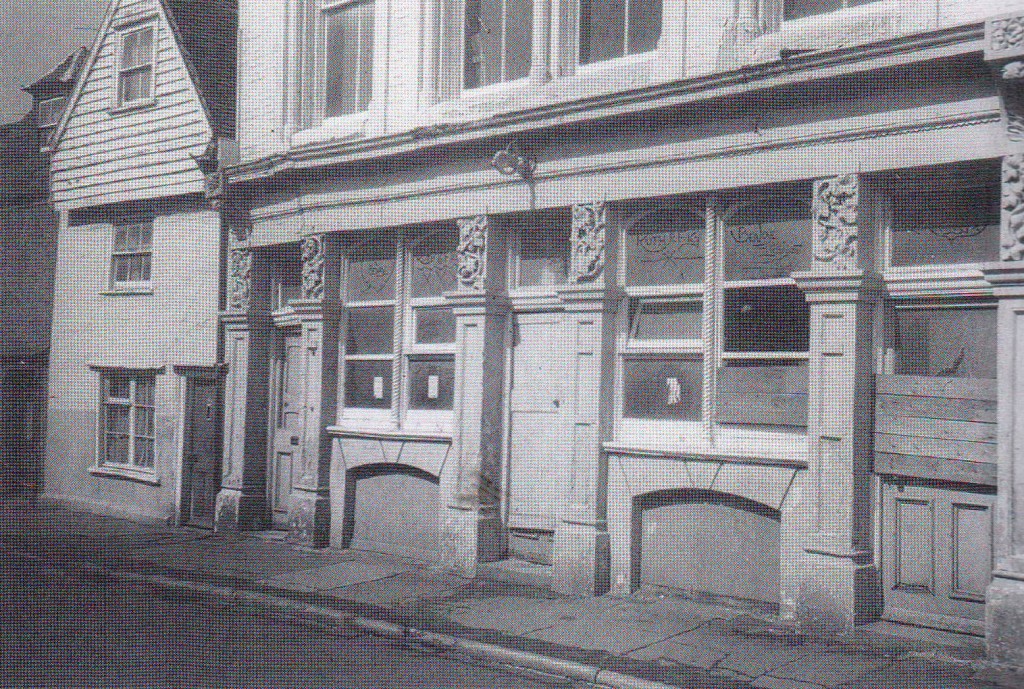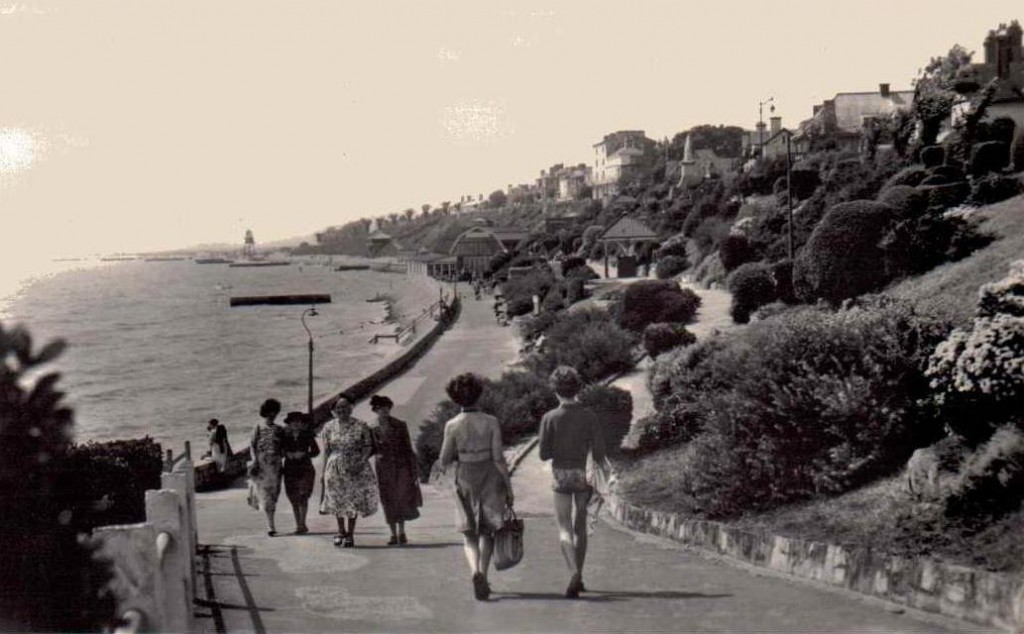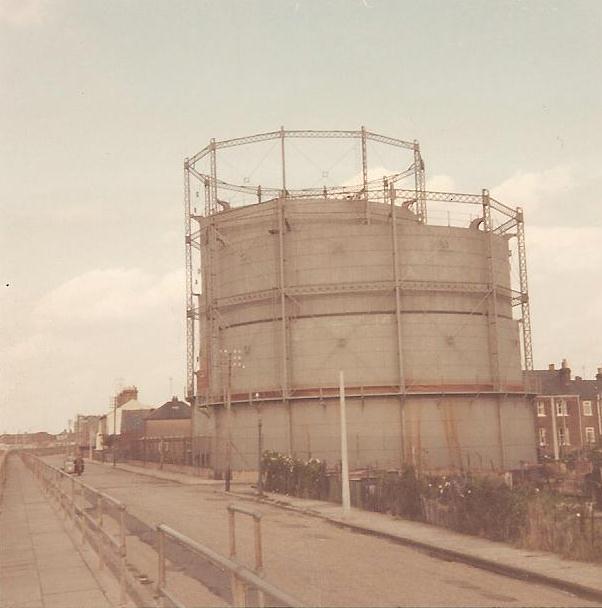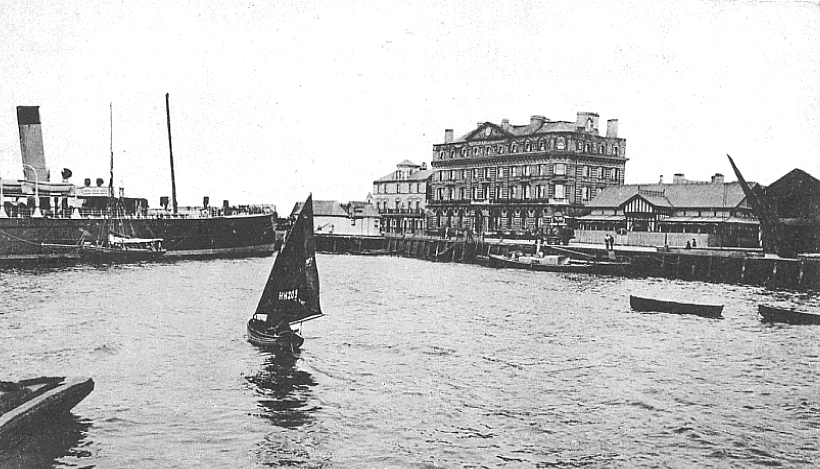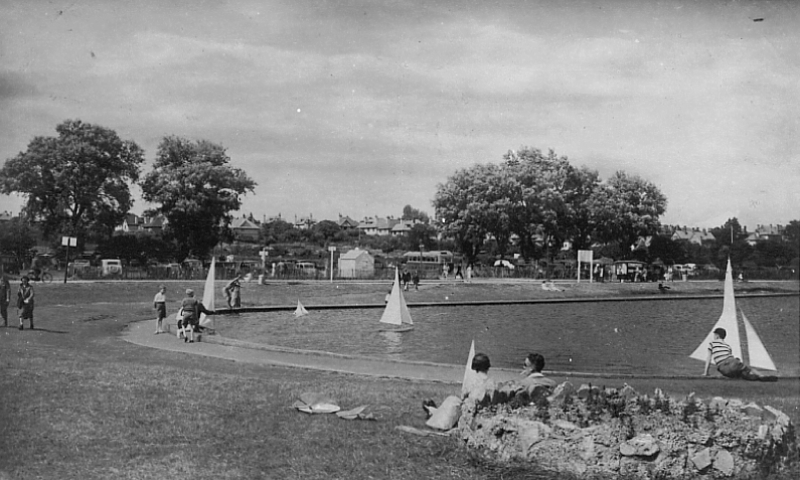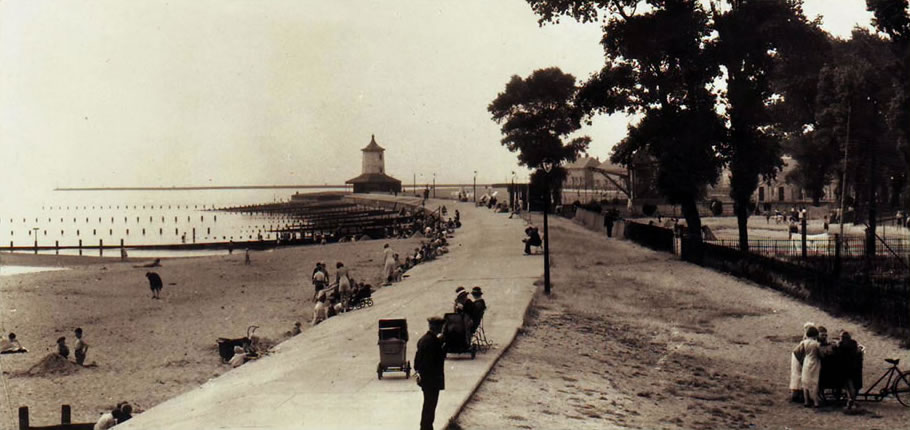
Memories
There are many types of memory… The picture in your mind when you think of your first school, your visits to the cinema or days spent on Dovercourt beach.
Sites like these are all about sharing information on our towns history and without people like yourself sharing your memories and stories they would not be here today.
So many people have information and images stored away in boxes that have not seen the light of day for many years.
Send us your memories and photos to be included on this page.
-
The Day the Sea Wall Broke
-
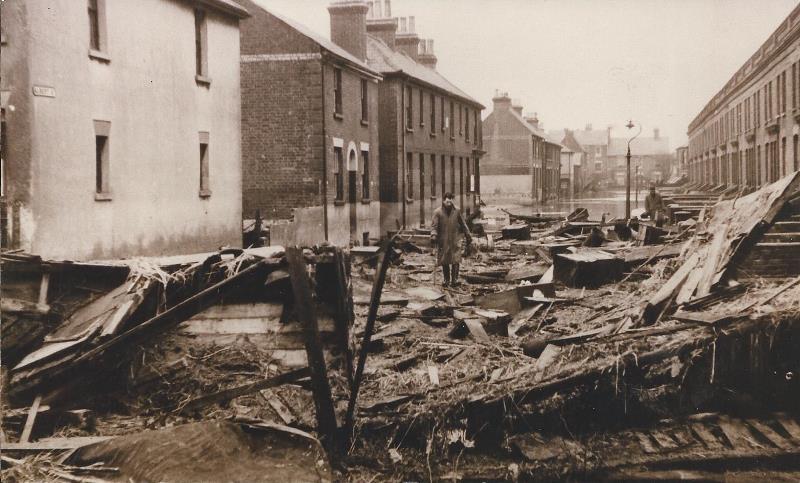
After the Flood
- I Remember walking to school one morning in a ‘crocodile’ with the girls from the convent in Dovercourt. We were stopped at the Police Station and told we could go no further. I could see the water lapping not far from the the police Station. When the water receded we walked into Harwich to see the damage, there was a boat in the school playground. The school and the catholic church were never used again and later demolished. Ruth Wright.
Memories of how Upper Dovercourt looked
To begin with there was no memorial at Upper Dovercourt and there were few buildings of any kind. The houses on Upper Dovercourt green were there, and on those days women had linen lines on the green on which to hand their washing. Upper Dovercourt was then almost cut off from Harwich, for coming down the Main-road towards Harwich there was only the Rookery, the vicarage, the small group of cottages opposite the vicarage and the old houses just before Manor-road.
There were houses in Manor-road and then there was just fields again down to Blue House Farm, Clark’s Cottages were standing, then came Clarke’s Farm, on which the Vacuumatic was built, then allotments, and then practically the one shop. This was a sweet and grocery shop owned by Mr Baldrey and later Mr Curl, it is now a private house.
Next was the Trafalgar, the little Methodist Chapel, Albany Grove was a meadow, and then came the Cemetery, a farmhouse, fields up to Vicarage Farm, and then fields again practically the whole of the way from there to Ramsey. by E.N. Gross
Manor Road and The Neighbourly Club
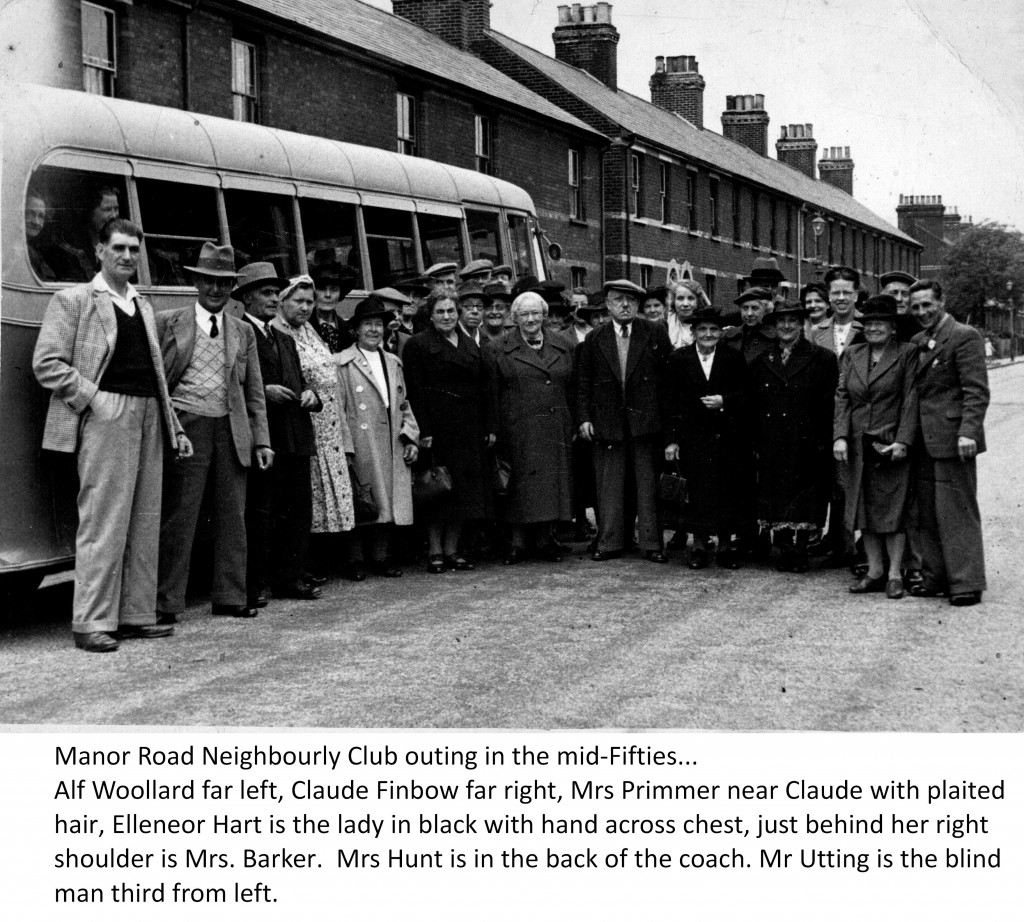
Manor Road Neighbourly Club outing
Manor Road in Upper Dovercourt doesn’t occupy a special location in the town, lying as it does between Main Road and Manor Lane. It is the first road off the south side of Main Road as you head east from Upper Dovercourt War Memorial towards Harwich. Manor Road is a street of mainly terraced houses arranged in blocks divided by alleyways to the sides and backs thus allowing entrances to the houses from both front and back, yet as World War Two ended this road gave birth to a very special community. Located between the backs of the houses in Manor Road and the local vicarage is a large allotment area, and in wartime the residents used this to keep themselves in fruit, vegetables, eggs, poultry rabbits and probably pigs too. Despite the hardship that all were suffering there was no stealing or looting of other’s property, if anyone was in special need, in hospital say or a father who couldn’t get back to his family then the neighbours made sure that the family was looked after. Some of the Manor Road residents were quite defiant during wartime and one house bore a huge painted V for victory sign on its front wall together with the dots and dashes of the Morse Code sign for V. It was a very self contained community, with three shops, one at the top on the Main Road known locally as “Hilda’s” after its owner, sold general groceries, fruit and vegetables, newspapers, cigarettes and even had a hairdresser above it. Further down the road was a haberdashery and wool shop run by Mrs Cooper whose son and family lived in the only detached house in Manor Road and even further down was Mrs Callahan’s little store that sold mainly sweets and foodstuff. Manor Road also boasted Callaghan’s coal yard, Dunningham’s the blacksmith and a Mission Hut where most of the local children went for Sunday School. The majority of the residents knew each other well and many were related – at the Main Road end and just across the alley from the back of Hilda’s were the Primmers, then Mrs Barfield grandmother of twins Irene and Mary, a little further on were the Barkers with daughters Sheila and Anne, followed by the May Mason with son Les and daughter Joan. May Mason’s husband died when he fell from the back of a fire engine. Next to the Masons were the Harveys, a family with four children and so the street went on with the Finbows, the Wrights, the Snelling family and on the opposite side of the road were the Uttings, the Felgates and the Hamblings, all of whom were to play a part in what was to become the Manor Road Neighbourly Club.
We moved into this community, not into Manor Road itself, but in the delightfully named 2 Manor Villas in September 1945 just after the war ended. Our house (now 395 Main Road) had been occupied by troops during the war and Dad had to spend many hours getting the place fit for a family of five to live in. As a qualified “brickie” and general handyman it wasn’t the technical difficulty of the task that slowed the project down just lack of money. Harwich Borough Council employed Alf Woollard as soon as the war was over and gave him the responsibility for overseeing the building of new homes to replace those damaged during the war. As Clerk of the Works he had a great title and as a staff man a guaranteed income even when bad weather laid the outdoors workers off, but this security came with the penalty of a low basic wage. Consequently he was always on the outlook for extra part time income and being the enterprising man that he was, and with his flair for organising, he soon found a niche in the local pubs as secretary or treasurer where he was responsible for Christmas Funds, Social Outings, darts rosters etc., in fact anywhere where he could help out, meet people who could use his bricklaying skills and maybe get a free pint or make a bit of extra cash. It was in this atmosphere of helping out, that he came into contact with the residents of Manor Road who had organised a hugely successful street party for the VE Day celebrations and were now trying to keep alive the wartime spirit of helping each other. Those who were there for the VE day party remember taking their own tables and chairs into the road, seeing the heaps of food (despite the rationing), and singing and dancing in the street to the music from a radiogram that Mavis Primmer’s parents had carried across the streets.
The focal point for the residents of Manor Road was the local pub the Royal; situated on Main Road between Manor Road and Kings Road it boasted a public bar, a saloon bar, several large reception rooms and a little off licence known as either the “Jug and Bottle” or more commonly as “The Snug.” Despite – or perhaps because of its small intimate size – it became a favourite place to sit in and enjoy quick drink and a smoke with favoured friends. On the few occasions that I was allowed to enter “The Snug” as a child I recall it as being just that; warm, crowded, smoky and very noisy. But it was in here that the locals got together to decide how they could follow up the success of the VE day party.
Today’s parlance would call it a Mission Statement but to the residents of Manor Road it was simply “Let’s make sure that the children and old folk who live in our road are happy and well looked after.” With that simple aim in mind, the organisation appointed key members. Mr Warner was elected Chairman; an unusual choice for the treasurer was a blind man Mr Utting, and my father Alf Woollard with his experience of several social clubs was appointed Secretary. Others who served on those early committees were Claude Finbow, Mrs Primmer and Tilly who was married to the chairman. Tilly was a tiny lady who lived half way down the street almost opposite Callahan’s sweet shop. Subscriptions were set and recruitment began; the hope was that those who could afford the fee would join with the expectation of some treats for themselves during the year but who would be prepared for their fees to go charitably to those who were sick or in need.
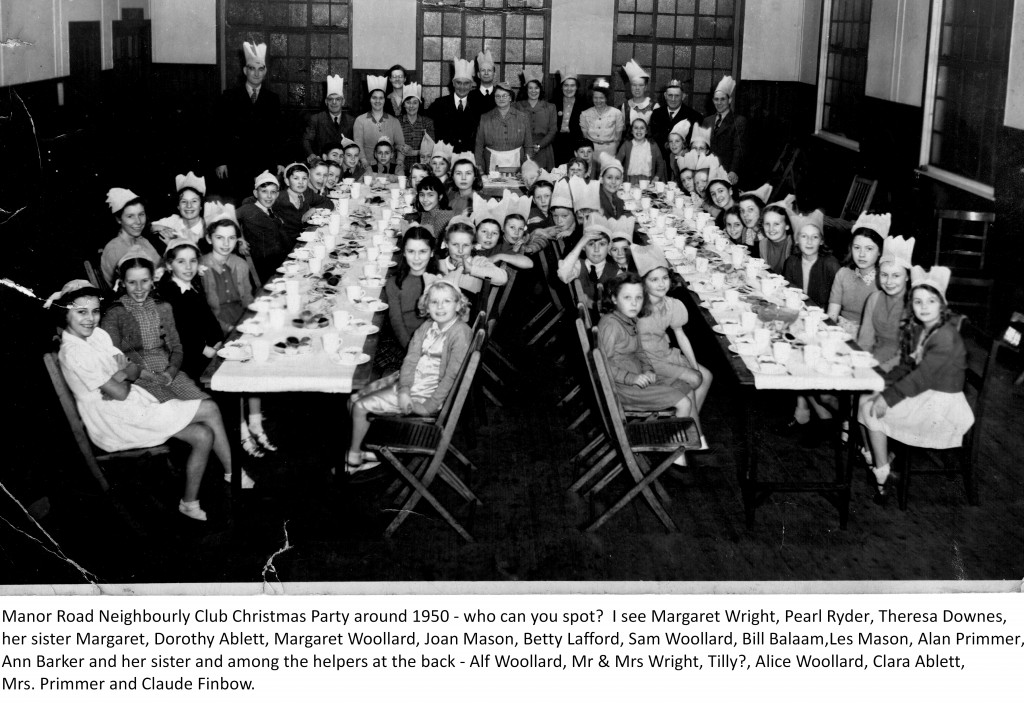
Manor Road Christmas Party
Initial reaction was slow with wartime wariness and low income making the residents uncertain about giving away their hard earned cash and the first children’s Christmas Party was a small affair held in a back room of The Royal. But the party was a success and as the residents talked over their adjoining back fences, more and more residents agreed that the Neighbourly Club was a worthy investment – particularly if a mysterious bunch of flowers appeared at their doorstep during hard times.
The committee continued to meet regularly and decided that as the youngsters had had their party then perhaps it was time for a treat for the older folk. The first of many charabanc outings was organised with a trip to Clacton so that “the old folk” could take a break after the long wartime years and enjoy a little fun. And enjoy it they did as my grandmother Eleanor Hart told us many times over.
The success of these initial events opened the floodgates for The Manor Road Neighbourly Club and membership requests poured in not only from residents of Manor Road but from those living nearby on Main Road and the adjoining King’s Road, Manor Lane and even from as far away as Lee Road and Tollgate. All were welcome and by the time that the next children’s party came around it had to be moved from The Royal to the Church Hall in Upper Dovercourt. This hall became the venue for both children’s’ and adults’ parties for years to come and if the children enjoyed dressing up for their fancy dress competition they were well and truly beaten by the adults. Anne Barker’s mum and dad once went as playing cards and there were policemen with uniforms made from wartime blackout material and a Dutch Boy & Girl. Perhaps the most adventurous was a sheikh with his harem – Mr. Wright being wheeled into the hall in a wheelbarrow by his wife and family – no problems with “blacking up” in those days! The dressing up continued with support of the Harwich Guy Carnival Torch Light procession and the Manor Road Neighbourly Club entered a themed float for many years.
Success followed success for over 10 years with membership increasing to its peak around 1955. During that time one of the memories that I will always carry is that of my father hunched over an old typewriter trying to decipher his handwriting of minutes that he had taken, or writing up subscription lists, sending requests for hall bookings, coach bookings and doing all the things that are demanded of a secretary.
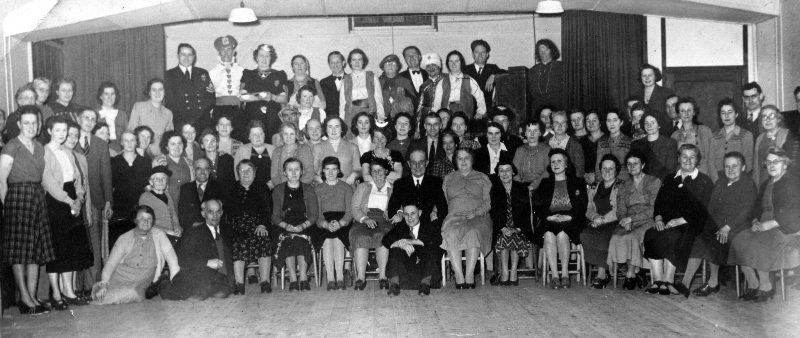
Manor Road Neighbourly Club party.
The Manor Road Neighbourly Club slowly faded away as television gradually took its hold on the local population and some wealth came back into the area to replace the wartime deprivation. Rationing ended and eliminated the need to pool coupons to buy treats for the young and old and those who were in their prime in 1945 no longer had the same urge to spend their free time helping others in 1960.
At its peak it had several hundred members and gave pleasure to countless children, adults and old age pensioners, it was a unique institution for a unique area in the town and I am so proud that my parents were a major part of it. In our photograph albums at home I have scores of photos passed on to me that show the outings, the parties and the little gatherings in The Snug and a couple of them are shown here. If anyone has other photos or memorabilia of The Manor Road Neighbourly Club I would be only too happy to hear from them. Sam Woollard
The Co-op
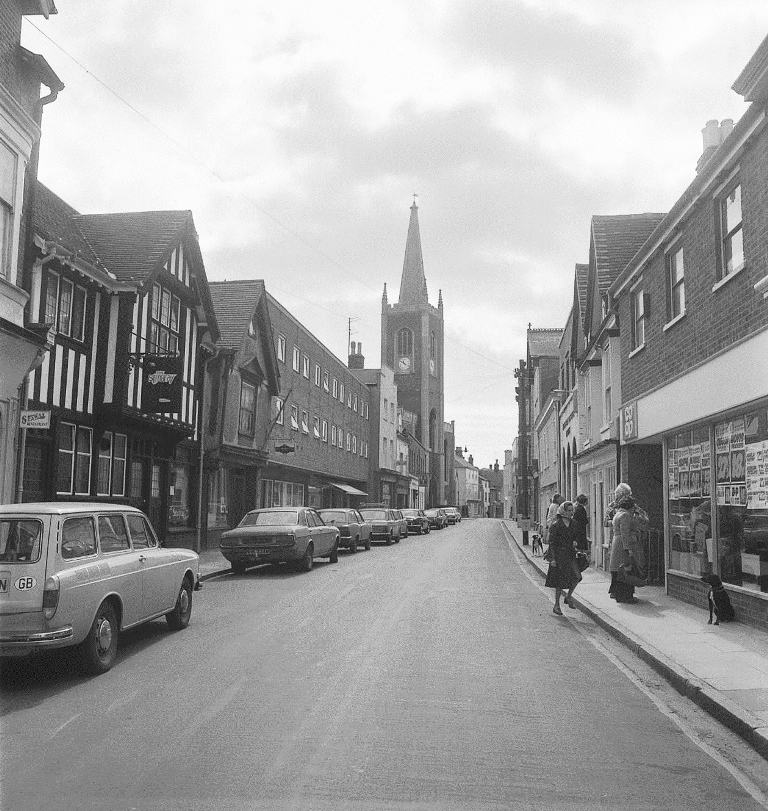
Co-op Church Street.
My first job after leaving school was working in the Co-op grocery store in Dovercourt; serving customers, weighing up and packaging food; and taking cheques to the cashier’s desk to pay. I can also remember weighing the sugar and having to learn to wrap them up into blue bags and also having to pat the butter up into shapes. When I left the Dovercourt shop I went to the Harwich store in Church Street because Dovercourt store was changing to self-service; and I was asked if I would like to go to the Harwich shop, I started collecting orders from customers to take to dispatch; collected money from previous week’s orders; delivered money to cashier. I worked at the Co-op for some time until I got married, I can recall having to telephone to ask for 2 weeks off for my wedding and honeymoon,
it was initially refused because the cashier had already booked time off, but they finally agreed.
“It was good times at the Co-op”.
https://secureweb1.essexcc.gov.uk/SeaxPAM/result_details.aspx?ID=1039678
- Interview with Ruby Cooper-Keeble 16 February 2009. Interview held at the Essex Records Office
- SA 49/1/2/9/1). Copyright of interviewee transferred to Harwich Society.
Kettle’s
Thank you so much for this picture it’s brought back a flood of memories. My granddad Bill Heath worked here for as long as I can remember. He used to bring me my Dandy or Beano comic depending on the day when we lived in Park Road then go thru the back & up the ally to Kettles. Never liked the Cream Soda (still don’t) but loved Vimto. by Zoe Coe.
I remember them coming round the houses selling soft.drinks dandlion and burdock ginger beer and cream soda. They were lovely.” by Julie S Beasley.
My Dad worked for Kettles in the 50’s…….Harwich and Parkeston F.C. got him the job in order for him to stay in Dovercourt and play for the club……..they did things like that then…….” by Carol Thomas Smith.
Palm Court
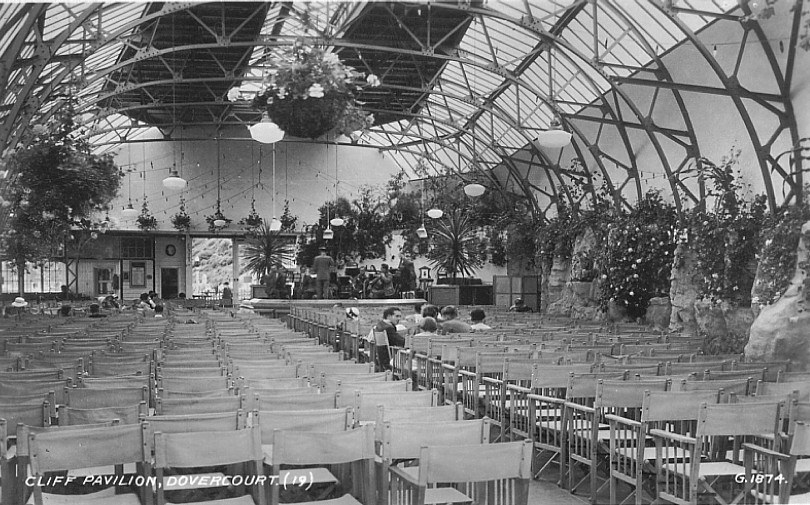
Cliff Pavilion
I remember walking along the promenade to the Pavilion. To continue our walk we had to go through the Pavilion. If my memory is correct it had a glass roof and front window and there were some palms and what seemed to a six-year-old huge greenhouse plants. I thought it was a most glamorous place.
I remember the words Palm Court. Ruth Wright.
A Childhood in Dovercourt and Harwich in the 1950’s
Blacksmiths Lane was the start of the adventure. In our oldest and ragged clothes with Wellington boots ( it was always best to wear boots as invariably water and mud of one kind or another was bound to be found) Opposite All Saints Church, between the wool shop (formally a Bakers) at the end of the Alms houses, and the playground of the school. Before heading down the lane, a few thoughts of the magnificent All Saints Church, a Norman construction with walls up to 4 feet thick.
It was always very hard to comprehend that this building was 900 plus years old . At that time this building would really have been something! There would have been no other buildings for miles around. Why was this location chosen at that time? Just because it was the highest point in the area? How was it financed? Who would have formed the congregation? It can probably accommodate perhaps 200 patrons. Was it ever filled to capacity? Does Canon Johnstone haunt the pews with his dirty shoes? Are my endless Sunday school sessions recorded anywhere? Is my own wedding day recorded in the ancient rafters…………
As we progress down the lane the rear of the woolshop gives away it’s secret that it was once a blacksmiths with remnants of stables and “smithy” artefacts left to rust away to oblivion. A small lane goes off to the right which I think led to a cottage which surprisingly never came under my curious gaze. To the left another, wider lane led off to the rear of the school and then to the rear of the White Horse Hotel where more stables were contained behind a high brick wall and a heavy wooden gate.
As we proceed down Blacksmiths lane there were leased garden allotments on the left most of which were carefully tended by an assortment of elderly gentlemen in cloth hats and waistcoats who presumably did not have sufficient garden space of their own in which to grow their family vegetables. Some had a makeshift shed in which their tools were kept and served to give shelter from the elements.
Blacksmith’s lane at this point sank somewhat with the hedgerows on both sides perhaps three or four feet higher than the lane. The lane itself was only about eight feet wide with a shallow ditch at each side. The hedgerows consisted of fairly thick undergrowth, with hawthorn bushes, bramble and as I recall, some elderberry and Hawthorn trees with an occasional willow. At about this point we always saw fit to find a suitable size stick that served as a stinging nettle destroyer, something to poke the undergrowth with and a rudimentary golf club when the opportunity arose with the right size stone. The stick was a perfect compliment to the catapult that hung from my back pocket and the sheathed knife on the belt (for some reason my mother never commented on the knife carrying but would have been horrified at the thought of her son carrying a catapult had she known)
The lane continued to dip until the banks were perhaps five feet above the lane, then there was a slight gap on the left hand side which was a path that would lead to Fronks Road where it came out at Smiths? Garage. At a later stage this lane was developed into a road that serviced about 20 homes that were built for members of the Fire Brigade.
Some 200 yards further down the lane the hedgerows flattened out and cleared somewhat and split, to form three tracks, with one track leading off to the left, fairly open and grassed, about the size of two football pitches flanked by a row of huge elms. These elms had seen the demise of an unfortunate pilot some years previously, who had sought to land his disabled craft in the open area, but unfortunately for him was unable to control the plane, which crashed into the trees, prompting a huge salvage operation which would have given the Harwich and Dovercourt Standard a nice meaty story for its readers at the time! Beyond the trees were a group of houses, which fronted onto Fronks Road and had a little lane that ran along the boundary of “The Grange” and the end of the row of houses.
At the fork in the lane, the two ditches either side of Blacksmiths Lane joined, and formed a large ditch which was never dry. It was deep but very narrow. I can remember clambering into this large “ditch” on one occasion, slipping , and in an effort to save myself heading headlong into the water had my hands outstretched having not seen the broken glass, and suffered a serious gash to my left wrist, narrowly missing the artery and tendons, but nevertheless very bloody and the cause of much anguish for myself and my companions as we ran to the top of Blacksmiths lane for help, having not been taught any first aid at the ripe age of about nine. Fortunately for me, having lost a great deal of blood and close to collapse a very kind gentleman in a car rendered first aid and took me off to the local hospital. The scar is still on my wrist after all these years. I must say that the driver must have been a very compassionate man, to have allowed this scruffy urchin, covered in mud, and bleeding profusely ,into his near new car. Times were different then………….
Back to the “Lane”. To the right of the dreaded ditch there was another lane, which curved round to the right through a forest of bulrushes which at times were so tall it was not possible to see over the top of them. As we walked the bulrushes gave way to shrubs and then to trees, mainly Elderberry which became quite thick on either side of the muddy track. To the right, a cottage was hidden behind the trees and one that we usually rushed past as somebody had once told us that something quite evil resided there.(Perhaps a rumour encouraged by the owners to keep inquisitive children out)
At this point there was another track off to the left which disappeared between trees to the right and the huge concrete anti-tank blocks overgrown with shrubs and trees to the left. We will come back to this track later…In the meantime there is wooden stile ahead of us. As we climb over the stile the vista that greets us will always have a special place in my mind. To the right there was a large pond, rather swampy, with bent and gnarled trees fighting for space. The water was full of water cress and tadpoles with lush grass to the edges.. Chris Hart
Donkey rides on Dovercourt Beach
In the summer holidays of 1924 and 1925, my young brother, Bill and I were donkey boys. We helped Mrs Osborne, who lived in the cottages adjoining Upper Dovercourt church. The donkeys were kept on the site where the Vacuumatic is now. We would walk from Tollgate, where we were then living, round up seven donkeys and, with the aid of a bit of encouragement, we would proceed to Dovercourt. We would stay there all day charging one penny a ride to the foot of the hill leading to the monument, and 2d right to the top.
If the customers, especially grown-ups, wish to take a photograph, perhaps we would get a little more, say 3d. If there were some days trippers at Dovercourt, Mrs Osborne made quite a bit and I should know for I had the task of carrying the money bag on my shoulder back to the stables. By the time we arrived, I knew what a bag of coppers weighed. We would then feed the donkeys and clean out their hooves. Our wages were 1s a week.
At the end of the season, we took the donkeys to the Ram and Hoggett public house meadow at Bradfield where they stayed for the winter months. Frederick Smith.
The Old Railway Tavern
I was born on July 16 1886 at the Railway Tavern on George Street, Harwich, which was owned by my father, Charles Salter. Among my early memories of Harwich was the arrival of the circus and fair on the village green, and the excitement of those occasions, the bathing machines on both the Harwich and Dovercourt beaches were accepted as part of the way of life. The Railway Tavern was the scene of many gatherings of the townspeople. Fishermen would play quoits and have their half-pints of ale after a day on the water.
Captain Precious, skipper of the Berlin would often stay at the Tavern when ashore in England. Mr Salter.
Dovercourt Convent
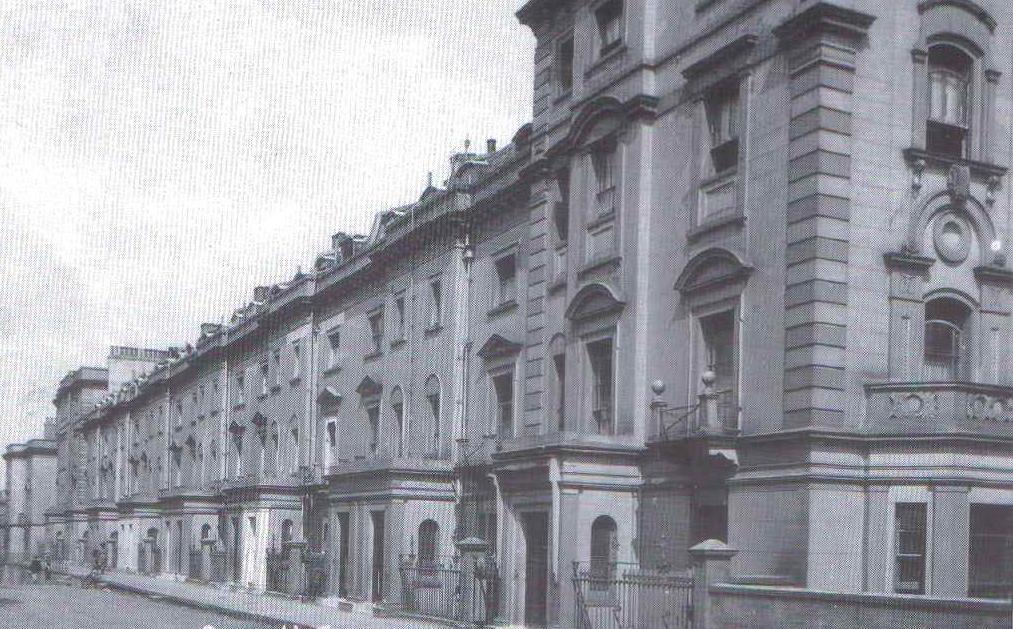
Dovercourt Convent
I went to Dovercourt Convent in 1953, I can remember it very clearly my first day there. My dad took me and I was very sad when he left. There was a very big tree in the garden and a wall we used to run up to have a look over the wall to see what was on the other side. When we went back to England in 1979 we managed to find the convent and the wall was not very high at all. I wish I could remember the name of the convent. I made some very good friends there and I did feel rather sad to leave.
I remember doing the nativity play at Christmas. We used to help in the kitchen and afterwards the nuns used to let us have a lucky dip as a reward. There were older children there and I am sure younger ones than me. I was there until the very bad floods of 1953 when they closed the convent down. I think I can remember a Sister Catherine who was very nice. It would be good if a Ruth Wright gets in touch again so we can compare notes. We used to walk around the corner to an area where there were swings that overlooked the sea, I think it might have belonged to the convent. Elizabeth Inns.
A Great Place To Grow Up
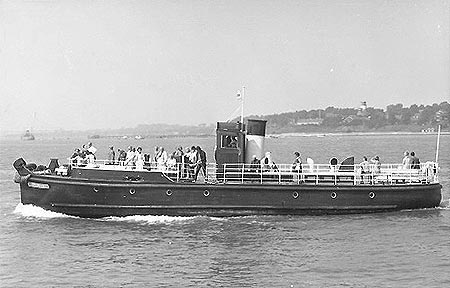
Brightlingsea
- Dovercourt & Harwich was a great place to grow up in, and I have many fond memories of it. My friends and I used to love riding on the Felixstowe and Shotley ferries, and generally just enjoying the simple but varied amenities of the town. Dennants’ hardware and toy shop near the station, always smelling of paraffin, was a boyhood Mecca: sadly all traces of it have since vanished. I last visited Dovercourt in May 2001, when all things considered it didn’t seem too much changed.
- Ian Newton.
The Hangings
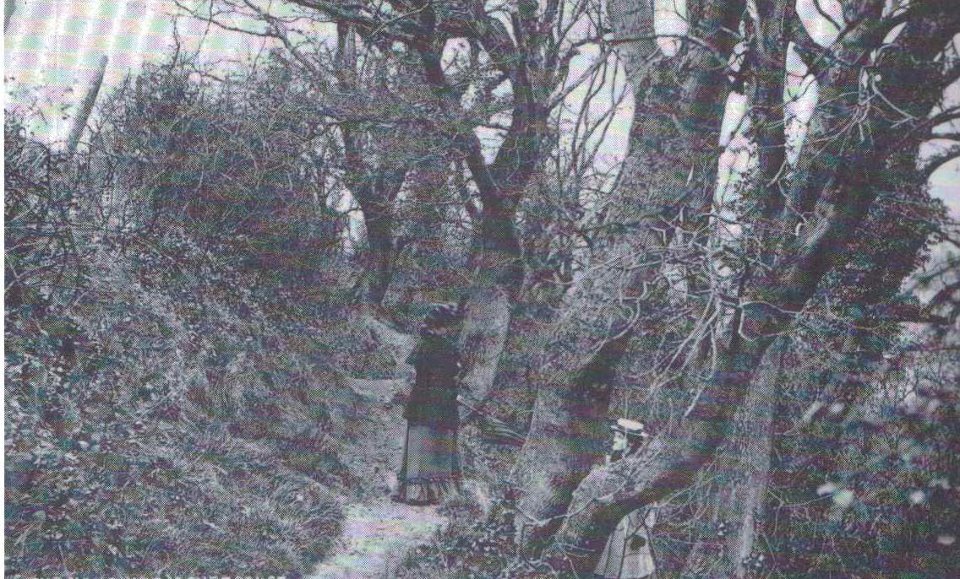
The Hangings
And does anybody remember an area called “The Hangings” Is the school still there? I tried to find some info on it but can’t. I still have a school report for the “Summer Term 1952”. There were 51 pupils in the class, the teacher was a Mrs Rowe, and the Headmistress was Mrs D Sammon. Of the 51 kids in the class I don’t remember any of their names and don’t have any school photos. Did they take any school or class photos then? Because I don’t have any of any of the schools I attended.
Two friends I do remember are John Bouldry and Patrick Stokes. Shortly after I attended Parkeston School my family left England to come to New Zealand where I am now. My father was transferred to the NZ Navy. I have very strong and wonderful memories of Dovercourt even though the time i spent there was very short. Brian Reynolds.
53 Floods Memories
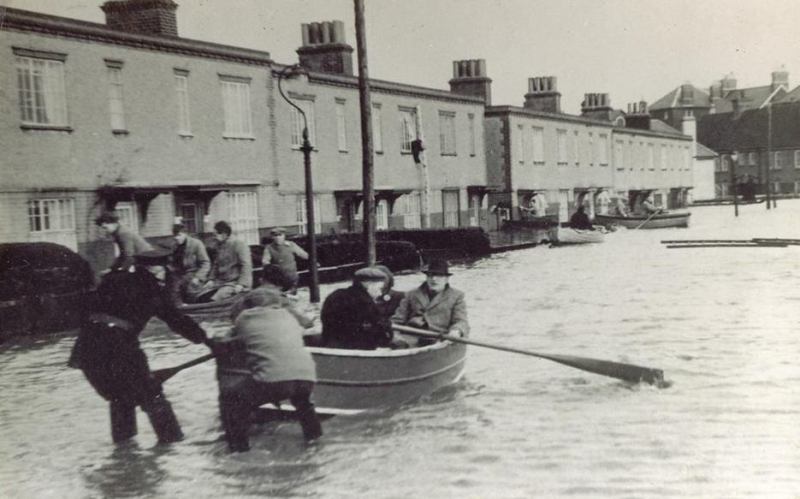
Grafton Road
I was 9 years old and living in Gwynne Road with my folks. We were boarding at No 44, owned by Mr and Mrs. Carr. They played Crib and he polished the brass in the house every Saturday morning. (A memory from a 9 year old – I also remember having baths in a tin bath in front of the coal range in the kitchen, filled with hot water in a kettle from the coal range). Anyway, my friend Geoff banged on the door, asked for me, and said “Come see the Flood”.
We ran to the corner and looked right, and saw the water which seemed to be about 50 yards away. We could see the two-storey houses beyond the waterline had their bottom storey under water. The next day, I think it was, the water had receded enough to make a trip down to the school – Harwich County Primary on Main Road – which was still partially under water, and to my dismay, and all the kids who were there too, written on the school building wall in big print for all to see, was a note saying something like : “All pupils to continue schooling at Parkeston School as of tomorrow” with directions on where to get the buses to take us there. So much for the anticipated holiday we thought we’d get.
Una Road
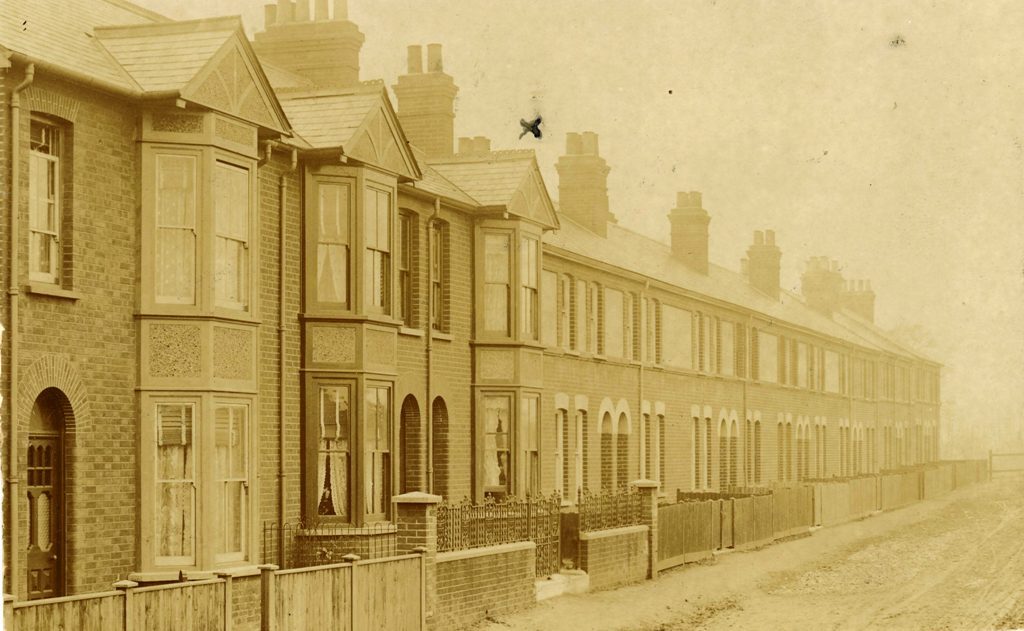
Una Road
(c) Rik Alewijnse
I was brought up in Una Rd in the 1960’s and 70’s. My mother still lives in the same house after more than 50 years. One thing that always strikes me now when I visit are the number of cars. I can still name the people who owned a car and the type of car it was in Una Rd when I was a child. Probably only seven cars maximum! Two Morris Minors, an Austin A35 van, Wolseley 1500, Reliant Regal van ( 3 wheeler), Ford Anglia, yellow and white, with american style spare wheel holder on the back and a Heinkel bubble car.
We did not own a car which grieved me terribly as I have always loved cars! On Sunday morning there would be what seemed to me dozens of people all dressed up in their best clothes, complete with ‘walnut whip’ hats for the ladies. All heading off for either of the two churches in the village. If I waited by the front gate, Mr Bell from 3 doors up would usually give me a packet of KP peanuts on the way home from the service.
Una Rd was called by some ‘the posh end of Parkeston’ as the houses were built later than the first part of victorian Parkeston, many having bay windows and small front gardens as well as large rear gardens rather than back yards like the properties on the Garland Road side of the village. With hindsight my memory of Una Rd is that it was quite smart with all the properties being well maintained all be it in a dated way for the time. I think many residents had moved in to the houses when they were new and therefore by the time I was born they were all getting older, and probably retired. Many were quite gentile and straight laced although there were scandals or gossip lurking under the surface as in any place. At Christmas Mr & Mrs Masterton always had lights in their bay window, that proclaimed ‘Merry Christmas’. How I would have loved those lights in our bay window!
When I was six I began piano lessons with Miss May down the road, a spinster who’s house was exactly as it was when first built, complete with a black leaded range in the back parlor replete with all the edwardian decor and ornaments. Howards’ shop on the corner at the end of Una Rd was where my friends and I would take our pocket money to buy sweets. I can still remember having six old pennies before decimalisation in 1971. The sweets were usually anything that would last and/or make your mouth sore. ie sherbet dip dab, cough candy twist, bubble gum, gob stoppers that made our tongues black, or if we had enough money, chocolate. I can still remember the first time I tasted chocolate. It was a bar of Galaxy, in a cream and pale blue wrapper. I can actually remember the taste in my mouth and no chocolate I have eaten since has tasted so good. Richard Webb.
Currants Lane
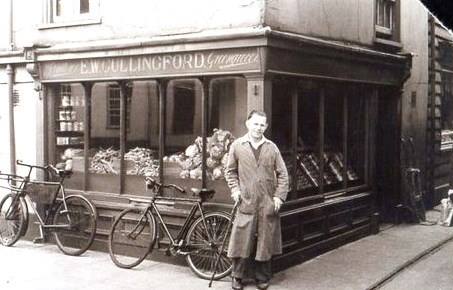
E.W. Cullingford
We would often see Sonny Cullingford walking to Harwich along the Main Road. As small children we were told never to stare. You see Sonny was walking with his leg spread and he had sticks under each arm. We were told that Sonny lost his legs during the war (we assumed WW1). He was a lovely, friendly man. His stance made him very short, so he was unimposing to children as well. Living in West Street and shopped at Sonny Cullingford’s. I remember the place as very dark.
Presumably no electric lights and I wonder if some even had gas lighting. It also seemed, even at such a young age, to have very low ceilings. A feature that would not have troubled Sonny. Even being so young we felt like we had to dip our heads going into the shop.
My brother being 7 years older than me would have firmer memories. I asked him if mine were correct and this is what he said:
“Gas lit like most of Currants Lane (where did that name come from?) and George Mills’ shoe repair shop. I would often see him repairing shoes by the light of a single candle. I seem to remember being told that Sonny was set up in his shop by some fund that helped amputees like himself after the war. Don’t know if it is true or not though. Nita Moore.
Trying to Remember
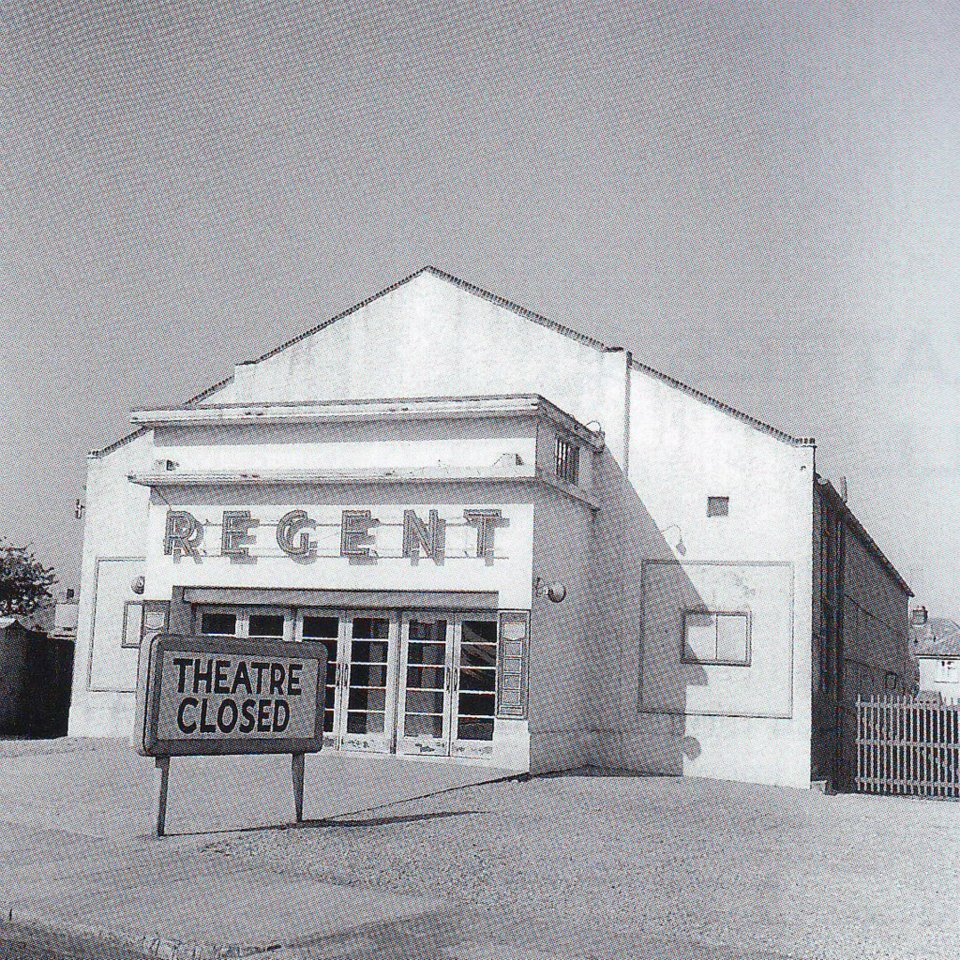
The Regent
I was born in Dovercourt in 1946, and lived there until 1957. My father, too, worked on Parkeston Quay, but moved to New England depot in Peterborough in 1956 mother and I followed once I had taken my 11-Plus exam. My mother was from Waddesdon Road, opposite the old school which had by then become the library. My father met my mother during the war when he was posted to Dovercourt. Although we moved away, and I now live in Shropshire, I still have two aunts who live in Dovercourt, so I return from time to time. We used to go to the Regent cinema on Friday evenings, as it was just over the road. I seem to remember that nearly all the films were Westerns! Mike Caird.
Growing up in Dovercourt
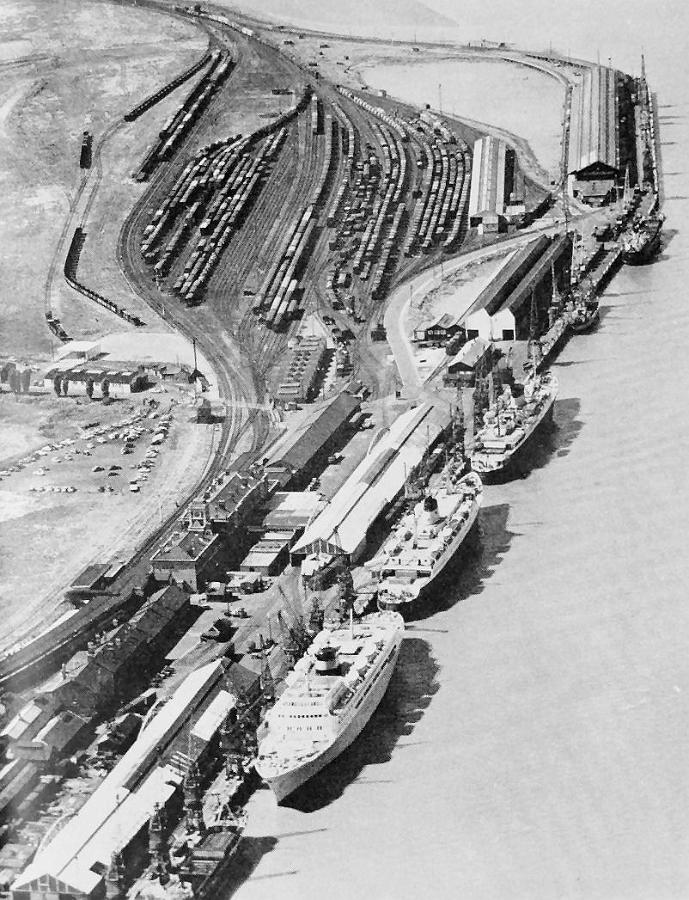
Parkeston Quay
I have been trying to remember the exact dates when we lived in Dovercourt, but I think it was something like 1953-57, while my father worked for the railway at Parkeston Quay. We first rented a place in Shaftesbury Avenue and then bought a house in Main Road. I was interested to see Martin Johnson’s post because I was a pupil at the nursery school that his mother used to run at the vicarage. It seemed like a very big place to a small child, with a huge garden that had lots of corners to hide in during break. I also had one term at the primary school in Main Road.I was briefly in the Sea Cubs and can still tie a round turn and two half hitches correctly. My best friends were the sons from Sutherland’s pharmacy they lived in a big house on Fronks Road with a solarium on top. I don’t remember a great deal about the shopping except for Bowtells, the grocers, where the bacon was sliced by hand and the butter sold loose. A shop full of evocative smells.
I can also remember going for walks along the Hangings, I think this was an old railway line that was full of blackberries and rose hips. My mother kept some wartime habits of thrift and made rose hip jam most years we were there. Robert Dingwall.
Dovercourt Memories
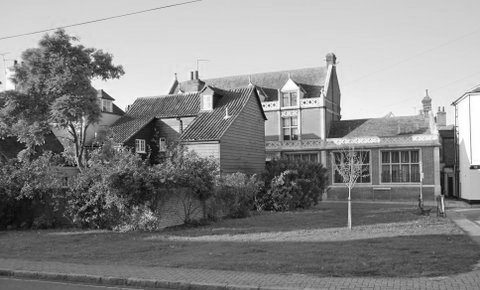
Wellington Road
My earliest memories living at number 12 Wellington Rd (now the plot has a bench upon it) there used to be an ally way between our house and the electric cinema. Our rear neighbours were the Slater family I think they had two boys Kenneth and Colin if memory is correct, I went to the Esplanade school passing the fire station on route. My younger brother Laurence and i had an accident whilst riding his tricycle against the school high wall facing the oncoming traffic and were hit head on by a car,
Laurence had a cut on his head whilst had a very bad smashed left elbow. I ran home and my mother Lucy took me to the fire station as they had a car there. Dr Levy operated on my arm several times over the coming weeks ending with a stay in Black Notley hospital. Raymond Chippington.
Born in Harwich
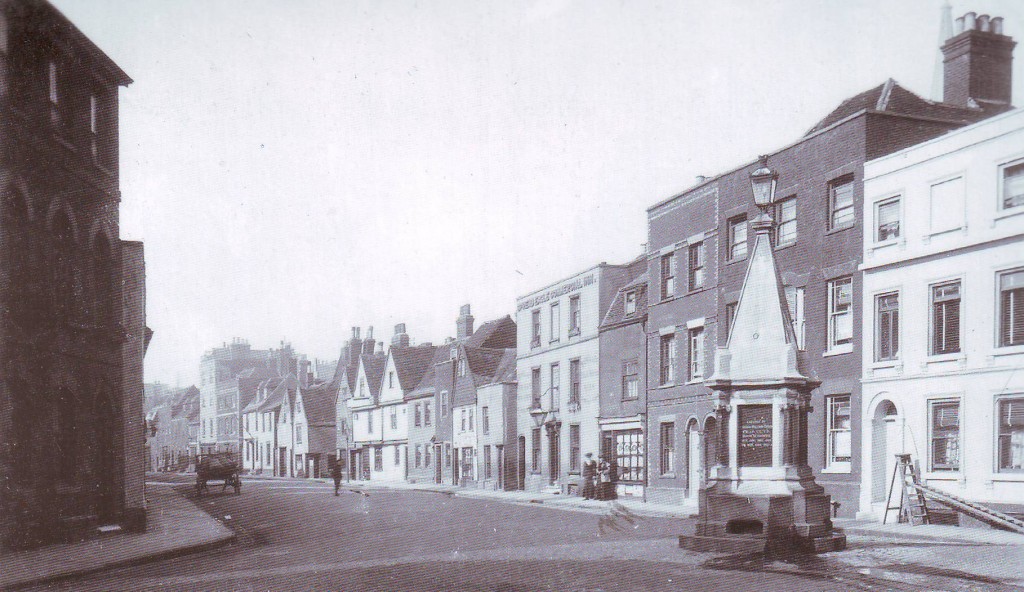
West Street
I was born in West Street,Harwich, in 1921 the 2nd of 3 brothers. Around 1924-25 we moved to 19 Sea Gardens (now 665 Main Road) and then next door to the house my father had built by Bradford & Sons of Mayes lane, Ramsey. Our garden was some 300 x 35 feet and ran down to Long Meadows. I can recall cows from Gross’s farm being driven across the Green down the lane which ran down beside the market garden owned by Mr Sparrow.
At the East end of Sea Gardens was Mr Balls Smithy, now has a bungalow on it, after the Smithy was an open plot of land on which a large hoarding with posters on for the Palace, Empire and Regent Cinemas. To the east of our long garden were 2 privately owned gardens, then a large number of allotments that went as far as the lane to Long Meadows. From Mr Balls, going east, there was no pavement, just a Hawthorn hedge until a house called, I think, ‘Caswell’, and then a row of cottages (still there) and further still another Market Garden (forget the name) then came ‘Old Timbers’, then 2 or 3 old cottages. Mr & Mrs Harris lived in one and the other (rather nicer) belonged to Mr Woolf the Stone mason. Then Church Cottages and at the east end of those was another Blacksmith shop. Never knew his Name, at the top of Blacksmiths Lane. Again, no pavement in those days and we often stopped on the way to Upper Dovercourt Infants School to watch horses being reshod and sometimes a new rim being fitted to the wheel of a haywain. I can recall the farm at Tollgate and later the huge barn being used as a repair garage. Mr Dawdry.
Dovercourt in the 1940’s
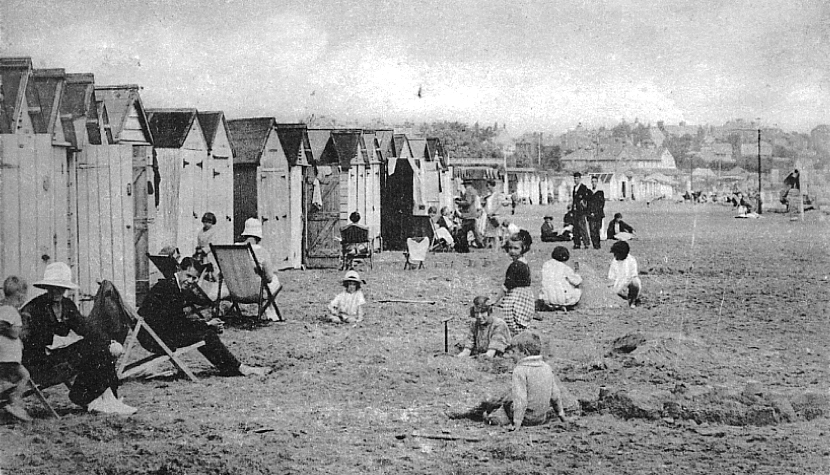
Dovercourt Beach
About the year 1947 my parents, sister and I went on our first holiday to Dovercourt. We stopped with a couple called Mr and Mrs Goode. He was a retired Trinity House man and he used to tell me all about the ships coming into Harwich Harbour, a person I will not forget. My parents liked winkles. Mr Goode told them to get the children to collect the winkles from the beach in the sand buckets and he would cook them.
This he duly did and the next day we all had a picnic on the beach with the cooked winkles, very nice. I remember someone calling to my father that you should cook them first – he must have thought we were getting them straight from the beach! Also, I remember something called the British Restaurants. This was a form of canteen where people could eat cheaply.
I presume this was because rationing was still on. Norman L.
The Electric Palace
Prior to the arrival of television the ‘Palace’ played an important part of the life of youngsters growing up in Harwich during the 1950’s.
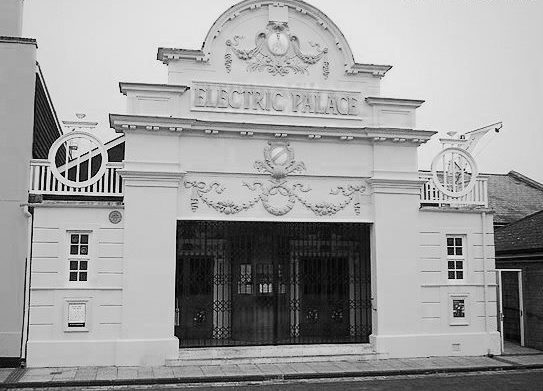
Electric Palace
There were two complete performances each evening usually starting around 6pm and these consisted of the main film, a shorter ‘B’ film, a Pathe News and occasionally a short travel film (usually in glorious technicolour). There was no set time of entry so you could go in say half way through the first showing of the main film and you would leave during the second showing of the main film when you reached the spot you had come in on the first time it had played! The two evening performances were separated by advertising, some of these were of a local nature but most were of a national character that were provided by Pearl, Dean and Younger and a trailer would also be shown at this point showing the next main film that would be on. The same programme was shown on a Monday, Tuesday and Wednesday and a new programme was shown on a Thursday, Friday and Saturday. Whatever was shown on a Sunday was for that night only.
The last performance of an evening ended around 10pm and the National Anthem was always played at the end and there was usually a mad scramble for the exits before it started. A lot of young Harwich men were then doing their National Service and were obliged to wear uniform when on leave and, as such, when the Queen was played on would go their berets and they would stand to attention and salute.
Entry conditions were strictly enforced but the majority of films shown at the Palace were rated as ‘U’ (general viewing) with occasionally an ‘A’ (accompanied by an adult if under 16) and very rarely indeed an ‘X’ (nobody under 16) as the vast majority of X rated films were shown at the ‘Regent’.
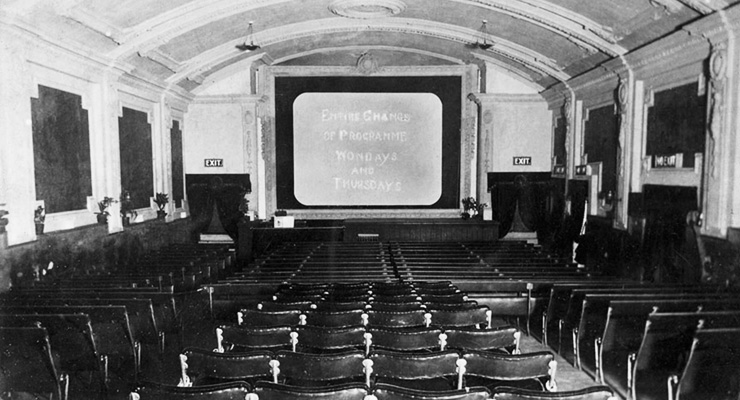
Inside the Palace
The majority of films shown at the ‘Palace’ were cowboy films featuring the likes of Roy Rogers, Gene Autry and Audie Murphy together with American made war films and action and adventure films featuring such as pirates, knight in Armour, Robin Hood etc. Many of these were black and white and colour films were still something of a bonus. The managers were Mr & Mrs Watson (who also managed the Regal) although Mr Watson tended to stay at the Regal whilst Mrs Watson spent more time at the Palace.
The films were always a big talking point amongst the pupils at such as the Esplanade School and at playtimes (certainly amongst the boys) they featured heavily in the games that were played. The youngsters were always noisy during the showing of the films and they tended to sit in the front rows whilst adults sat at the back. When, for example, the 7th Cavalry rode to the rescue and saved the wagon train from the red indians loud cheering would always break out and the usherettes would come down the aisles shining their torches on the ‘offenders’!
Ice creams were sold during the adverts by an usherette with a tray but if you wanted sweets to eat during a performance you brought your own with you!
The ‘Palace’ was a wonderful old cinema and provided many happy hours for Harwich youngsters in the 1950’s. Peter Haywood.
Many Happy Memories
I used to live in Harwich I moved away 19 yrs. ago and seeing all these pictures have brought back so many happy memories. I times I spent on the promenade with my mum. “By Tyna Gilliatt.
Memories for me mean travelling down the hill as fast as I could on my bike on the way to school wow, that’s over 20 years ago. Mark Weller.
The Big Storm

Dovercourt Cemetary
Upper Dovercourt cemetery. I was living there the night that the hurricane hit in October 1987. What a fun night that was! by Nigel Brett.
I played truant from school with my friend, but hid under the bed….mum used to go to work early then pop back in her tea break, so we had to hide and be very quiet as she did actually make the bed we hid under on at least one scary occasion…she never caught us. Ann Coltman.
The Band Pavilion
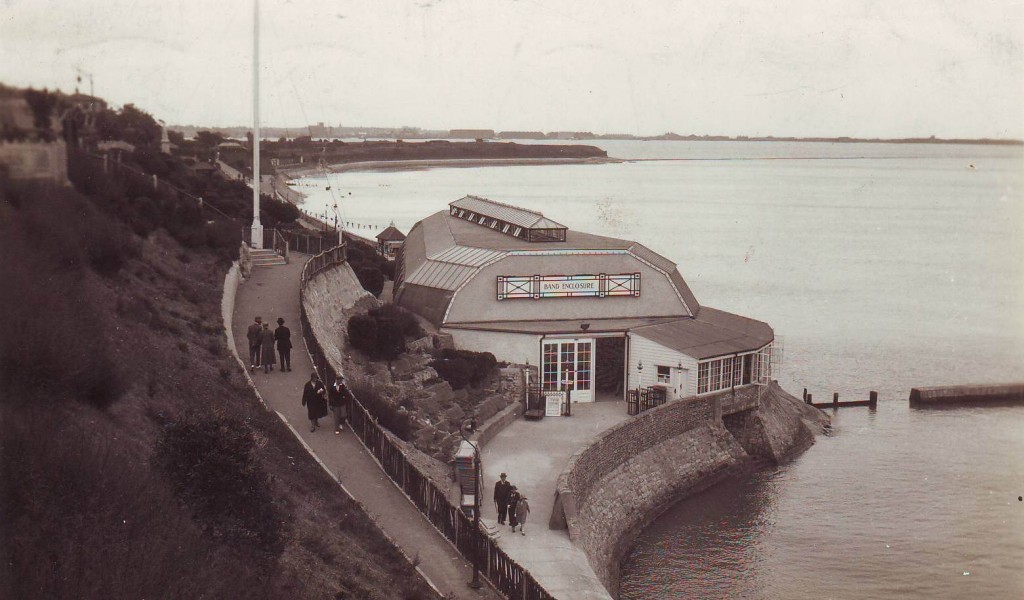
Band Pavillion
Sunday was Concert Night, Saturday night dancing, Friday night was local Talent night, Tuesday was Party night was always something going on – the last band I can remember toward the end was the Dr Groot Orchestra. They stayed at the Alexander Hotel Marine Parade (now senior citizens residence) oh my happy days! Betty Holloway.
Life at the Alma
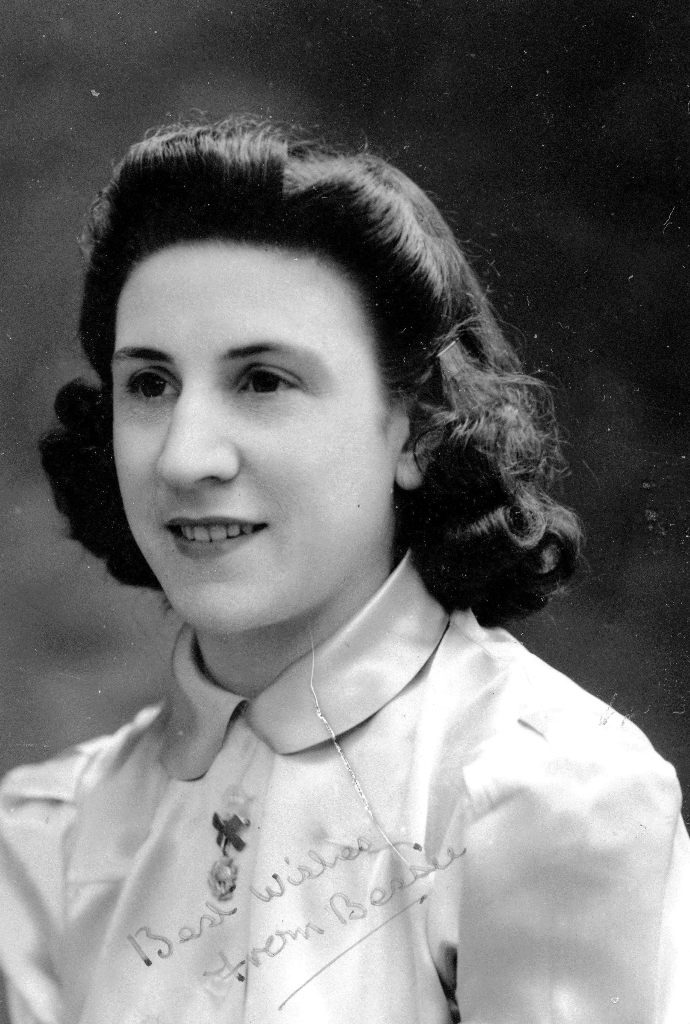
Bessie O’Dea
Born in Orford Ness in 1921, Bessie’s parents moved to Harwich in 1931 and moved into the Alma public house, Bessie recalls that beer was 4 pennies a pint, and a drop of whisky was 7 pence and woodbine cigarettes were 20 pence a packet , the Alma was mostly frequented by Fishermen from Tollesbury who would moor their boats at the quay on a Monday and return home on a Friday and bring bunches of live fish. On Harwich quay I can remember going on Trinity pier and there was a big tug and when we were kids we used to go down the steps onto the tug, one day I started pushing and the next minute I was in the water and had to be pulled out as I could not swim, after leaving school my father wanted me to work in the pub cleaning and some bar work and every Sunday morning we had to get up at 6 am and go outside into the yard and light the copper for hot water and scrub the bar floor.
Opening hours on Sunday was 12-2 & in the evening 7-10 and weekdays 1030-1430 & 6pm -10pm. And when the yeast factory shut at 10 pm the opening hours were extended to 11pm so the workers could enjoy a drink after a hard day’s work.
In the Alma was a piano which I would play after closing time my father sent me to music lessons in King’s Head Street and I found out that I could play better by ear than by music, the Alma was the only pub in Harwich that had music 7 nights a week 52 weeks of the year and I never had a day off. Cleaner in the morning, barmaid at dinner time and a pianist in the evenings.
When my father took over the Royal my husband worked as a barman for my father, my eldest daughter Frances was born at the Alma and when my father died by brother bill took over the Royal I moved out of the royal in 1984 when my husband had a heart attack in the pub and lived with my daughter Frances.
Extracts from a interview with Bessie O’Dea (Chambers) 27/11/2016 by David Whittle (Harwich Society).
Gages
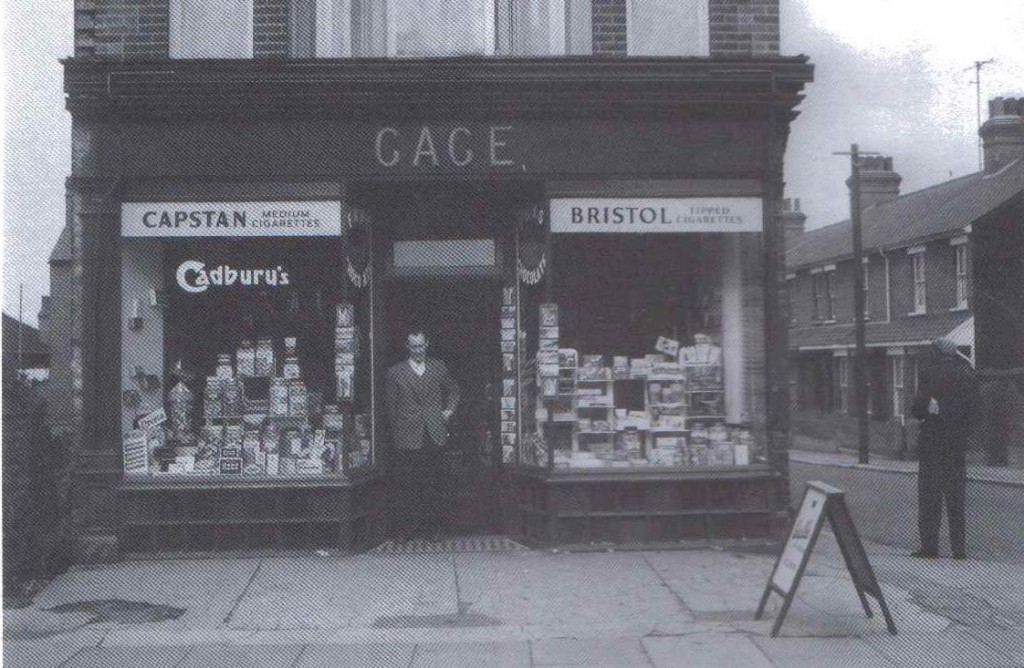
Gages
Best sweetshop ever, brings back lovely memories as a child, and the fish and chip shop round the corner. by Sue Heath.
I lived in waddeston Rd from birth till i was about 5 , i remember my grandad getting fish and chips there , such a treat in the 60s. By Gail Crisell.
I remember the lucky dip bran tub and getting a little interlocking metal puzzle. Keith Lawrence.
Bathside Memories
I moved to Bathside in 1940 when I was 7 months old, first to Vansittart Street, and then just before my 5th birthday we rented a house in Maria Street. I started at Bathside School when I was 4 years old, as the war was still on we had to go into the air raid shelters in the playground when the sirens sounded after the all clear the parents or guardians came to collect us to take us home. I remember being in Miss Cross class, and, being sick while we were singing around the piano, this was caused by drinking warm milk, I always hated milk, so in the future I was not given any. When I was 7 years old I went to Esplanade school then onto Waddeson Road for a year. followed by Hill school until 1953, when we were flooded out.
I enjoyed my time in Bathside as after the war there plenty of places to play. There were several bombed building sites which made good hiding places, and, provided a constant source of chalk and marble for our games of hopscotch. We went across the mud to Bathside beach where we had to clamber down the war defences onto the sand, there cockles and winkles to found there also crabs. Living in Bathside we were very safe as we did not see much traffic, so the streets were our playgrounds. On bonfire night bonfires were built along the mud and then we waited for the big procession to come from Dovercourt, then we followed all round Harwich to Lee Road where it finished. I always had 3 pennorth of chips Monday-Saturday except in the summer when it was new potatoes as they were too expensive, I left enough room for these even after I had had my tea. In 1953 when the flood’s came I was asleep in bed, and, when I looked out of my bedroom window I saw fences and sheds floating past. We were lucky to have been in a 3 storey house as the basement was full of water, and, it was half way up the next floor. My tortoise was hibernating under the stairs, .and, got forgotten, he wasn’t rescued until the water went down, he carried on hibernating, and, lived for many more years. We were rescued about midday by rowing boat, and, taken to an army lorry then onto the refugee centre at the Barracks by the park. Later on my uncle came for us and we take to Tollgate where my aunt had a big stew going as she was had been waiting all morning. After dinner I went Sunday school with my cousins, I still had on my pyjama top as it had been too cold to take it off when I got dressed. After staying with my relatives for a month we moved to West Sussex where I am living today, although I have lived in Hampshire and Hampstead, London.
Ann Lamb / Burridge.
Harwich School
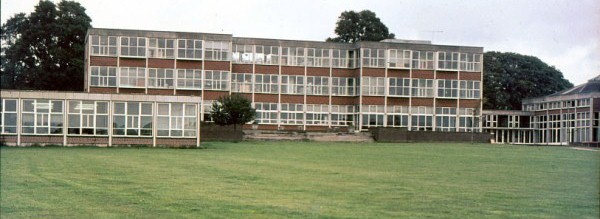
Harwich School
I loved Friday night discos in the hall with my friends. Mr Cornes on the turntables belting out the tunes of the day, but remember i had to be home by 9pm! One snowy day some boys decided to throw a snowball at the window of A14, glass everywhere! A14 was the place to go to listen to records of the 70s.” Gail Lucas.
The Retreat & Beach Fun
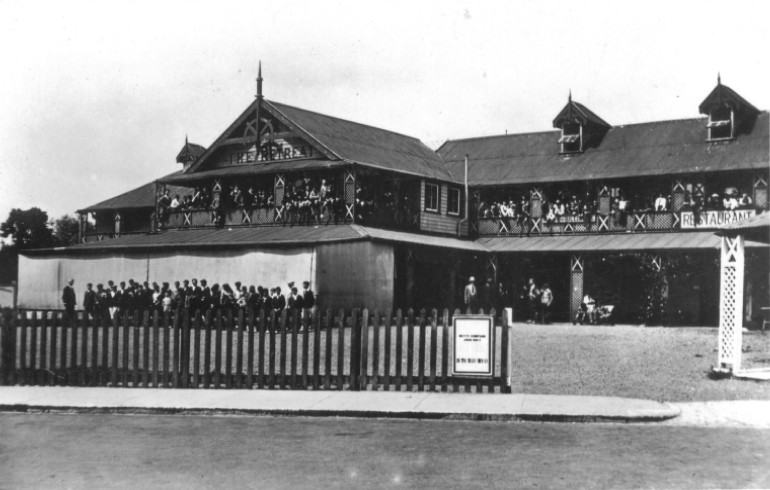
The Retreat
One year I think we stayed at the Retreat, a large wooden building I think, close to the front, where group holidays were spent. I well remember the Phoenix public house,near the Retreat. Mum and Dad spent many a happy hour there not the modern happy hour, that hadn’t been invented then. There was always good company there, I imagine, and we girls played around outside, enjoying our arrowroot biscuit and lemonade.
Even to a child it seemed he had a warm attitude towards everyone. One day a plane came down in a field beyond the far end of the front, in the area where I believe a holiday camp was later built. It created great excitement and William took charge of me, being the smaller, and either carried or gave me a piggy-back, running with loads of other people to see this wonderful sight. On the way we would have passed a pond where there were often numbers of eels. I believe people fished for them. Stewed eels were one of my Dad’s favourites, and I’ve always liked eels, however prepared. Joyce Barrett.
The Very Best of Times
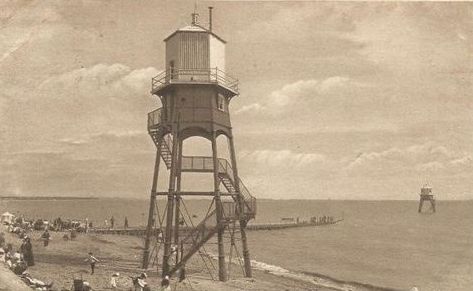
Of course in nostalgic reminiscing, it never rained on holiday, did it!? We always sat near the lighthouse that is still in place. Photos were regularly taken on its steps-sadly they have been lost, with most of our childhood snaps. Despite Dad’s one leg he was a remarkable and courageous diver. Many a time he went off the breakwater at high tide. How he got safely along the breakwater, even the few yards needed, I shall never know? Mum and Dad got to know three young men who were always full of fun, and gave us young kids experiences we could not share with Dad.
The sort of high-jinks that we only played with uncles, like being swung around and somersaults, and all the usual things that normally Dads can do. I shall never forget, their names were Dick, Cecil and George, and several years they were there at the same time as we were.
They loved to torment Dad, and once they turned him upside down, each one holding an arm or leg. Mum told of the hilarious search in the loose sand for his money! Very close to the putting green on the front there were the toilets, and a shop with all the favourite beach paraphernalia, and sweets of course. Some evenings Mum and Dad would go down to the Phoenix, and leave us in bed with sweets and comics that we’d bought on our way back from the beach. Joyce Barett.
Into Harwich

Interior of Cliff Pavilion
Whatever we missed because of Dad’s disability was amply compensated for in various ways. He worked in the Milwall dock area for Trinity House. So when we were on holiday he always arranged at least one day’s fishing from a light vessel in Harwich Harbour. As we got old enough, he took us girls as well, and I certainly found it all a great thrill. Nothing would have persuaded Mum to go in a rowing boat and up a rope ladder.
I was never quite sure about Marjories feelings on fishing. I suspect that she didn’t quite approve of the fish being killed when they’d been caught. One of the men on board would do this for us, and re-bait the line. Our catch was usually a few small dabs,and maybe crabs. If Dad went on his own, we would walk around Harwich with Mum, and she would invariably buy sweet prawns, beautifully packed in a box, something like Turkish delight packaging.
My last reminiscence was a particular highlight for us this was definitely a best frock night. On one or two evenings we would go to the Pavillion for a concert, and I sat enraptured as I listened to the music and singers, and watching was strong magic for me. The whole experience gave me a feeling of grandeur, and I realise now that my love of seeing live performances stems from those evening, a love that has never waned. I am always grateful for those wonderful days spent at Dovercourt. Joyce Barett.
The Sinking of HMS Gypsy
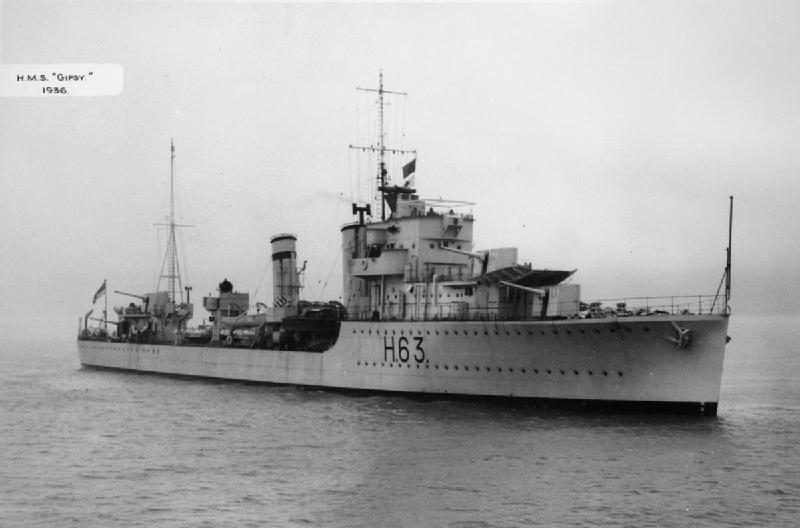
H.M.S. Gypsy
In the very early part of the 2nd World War Harwich had to deal with injured survivors from ships sunk by magnetic mines. The Dutch liner Simon Bolivar was sunk not far from Harwich on 18th Nov 1939. Then, further on, came the event which many locals vividly remember…the sinking of the destroyer H.M.S. Gypsy, after hitting a mine which had been laid in the harbour itself. A disaster which has since formed part of the collective memory of the local community.
G.S.Dutton recalled “When I go on the Harwich sea front I can still hear the screams of the drowning sailors of HMS Gypsy”.Hilda Woods has also recorded her memories of this time: “I can well remember that because I was in bed and there was this explosion. I got into my clothes and we all rushed up Bay Road, and there was crowds and we could see this boat blazing. There were crowds all along the sea front, it created a lot of light, seeing this boat blazing. We stayed there for about an hour then went back home”.And something Lydia Whitnall former licensee of the British Flag pub in Harwich will never forget is the crew of the Gypsy coming into the pub shortly before that fateful event. Hilda Woods.
Michaelstowe Hall
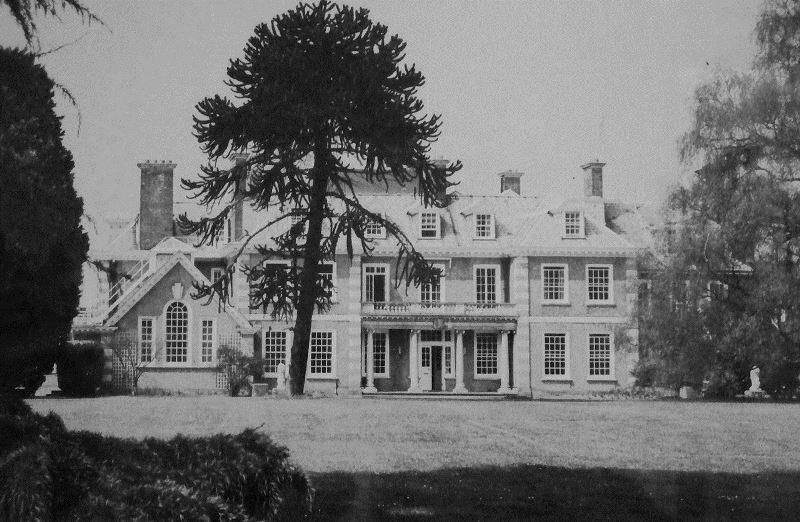
I remember going to the summer fetes there with my mum in the early 70s. My picture was in the Standard once. Dick Emery opened the fete one year and I was standing in front of him as he signed an autograph for me. By Coral Gillespie.
My friend’s mum worked there and I remember going to the garden fetes etc. with her. We always knew it as ‘The Naughty Boys School ‘ and were strictly forbidden to talk to any of the boys!!” Julie Hartnup Devine.
Woolworths
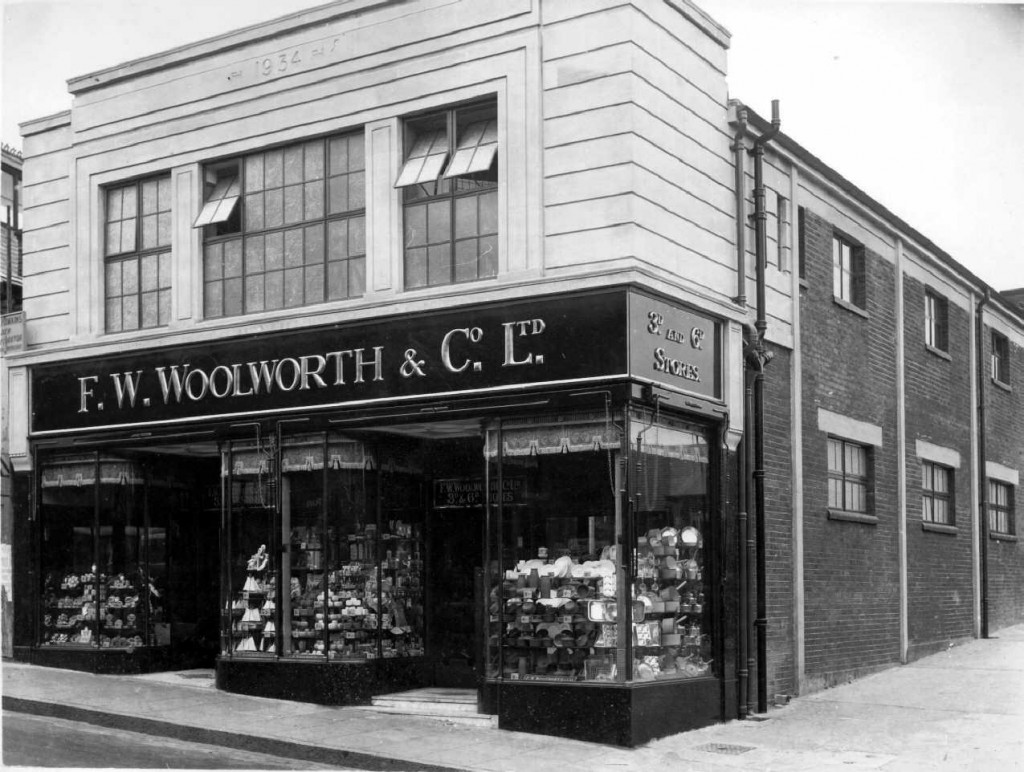
Woolworths
My mother left me outside Woolworths in my pram. When she came out I had gone as my brother has come along and decided to take me for a walk up the lane at the side.”by Andrew Stonham.
I used to love going in their when I was little, had proper tills and lovely old wooden counters with glass. Was that lovely little lady with the red cheeks and lipstick called Nancy? Lauren Simpson.
My mum and auntie worked there and used to deliberately drop biscuits as they would then be sold cheaper. Maxine Gardner.
A Cold Winter
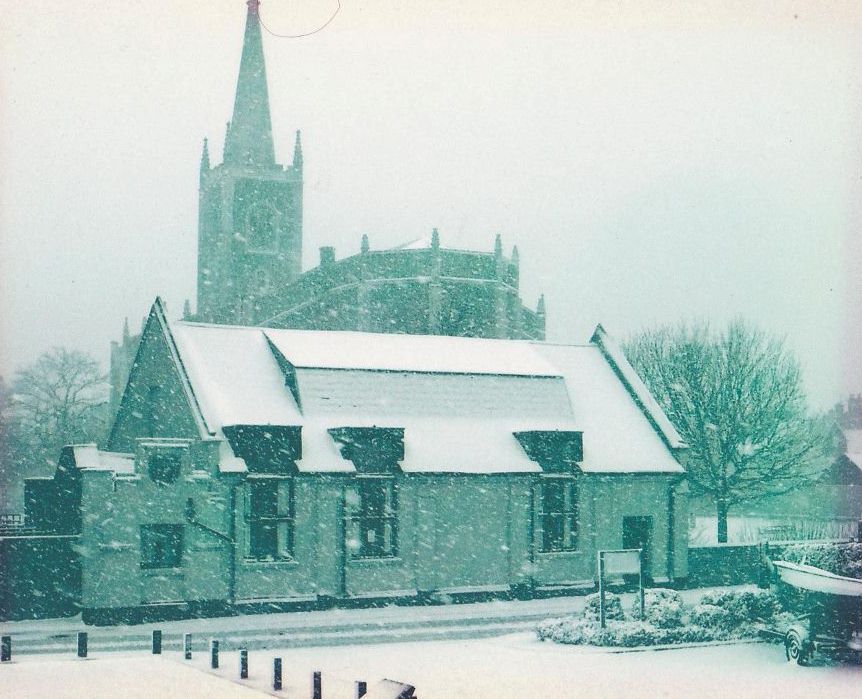
Esplanade Infant School
1947 was a very cold winter, I was at the Esplanade school although there was a heater in the classroom we were told to keep our outdoor coats on to keep warm enough to do our lessons, consequently when we went outside we were frozen not having had the benefit of something extra to put on. Our pipes were frozen at home; I remember my Grandmother collecting snow in a saucepan off the top of the air raid shelter to melt down for cooking. During my time at Esplanade school we used to do pageants on Harwich Green next to the crane, I don’t remember it having railings round it at the time, the teachers used to dress us up in old sacking to enact whatever it was. I don’t know if it was Lord Mayors Day, but, I remember standing with all the other children outside the Town Hall, and, we were thrown currant buns from an upstairs window. I think pennies were thrown at some time but my memory is hazy on that, does anybody remember that. In Old Harwich there was a sweet shop called Barkers selling homemade sweets, lovely humbugs, if you took a bag of sugar the sweets were offered in exchange. I used to like to watch the shrimp boats coming in with all the fresh cooked shrimps. They went straight into the fishmongers where we bought them at 3d a pint. I haven’t eaten shrimps since I left Harwich in 1953 as I have never found any as fresh as those. Living on Bathside we had to cross the railway to get to Esplanade school, when we used to go back after our dinner break we often found the trucks that were being loaded on to the train ferry blocking our way, the only choice we had was to clamber across the trucks which was safer than going underneath. There was a fountain in Harwich near where the dairy was near to the tall lighthouse, apparently there was a lot of controversy over this structure as some people wanted it moved and others wanted it to stay, one night it blew up, I don’t think anybody ever found out the truth about what happened. Ann Lamb / Burridge.
A Haven of Tranquillity
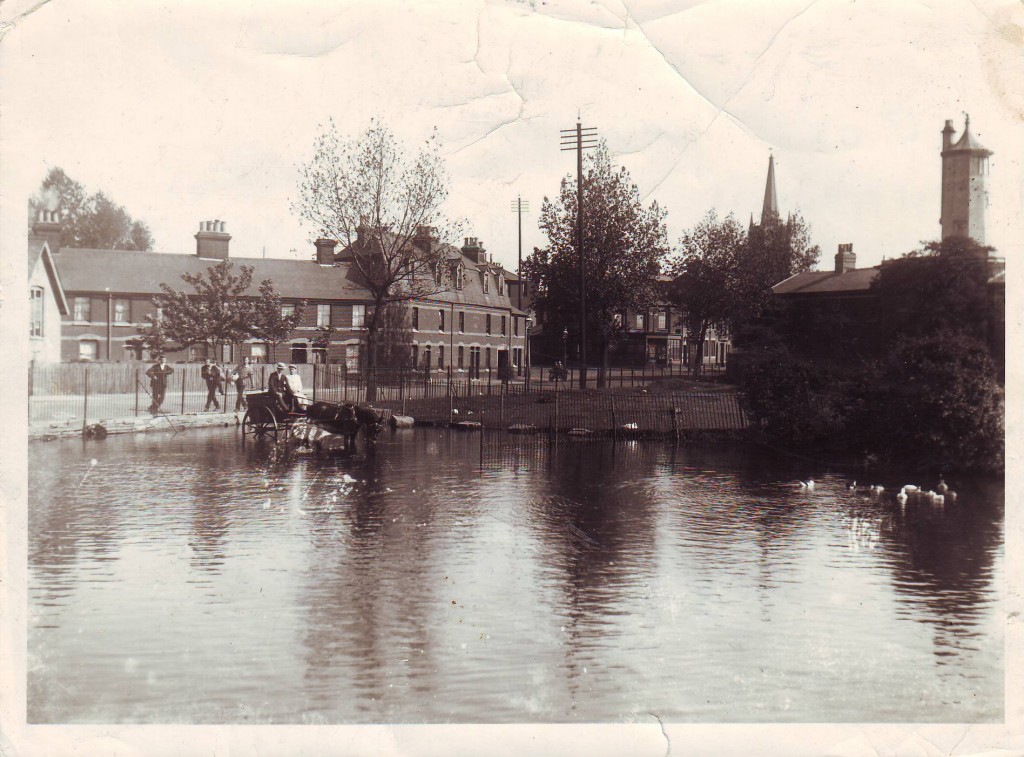
Cox’s Pond
Cox’s Pond is a delightfully peaceful oasis, situated just before the entrance to the Old Town. It contains a pond-of course, a fountain, public seats, ducks and geese. But in earlier years it was also something of a childrens’ playground,”The fun had by the children hunting for coins in Cox’s Pond. Girls would often wade into the water with their dresses tucked into their knickers, and occasionally have the great delight of finding the ‘Top prize’ of half-a-crown which had thrown into the water by a passer by. Essex Records Office.
Fryatt’s Funeral
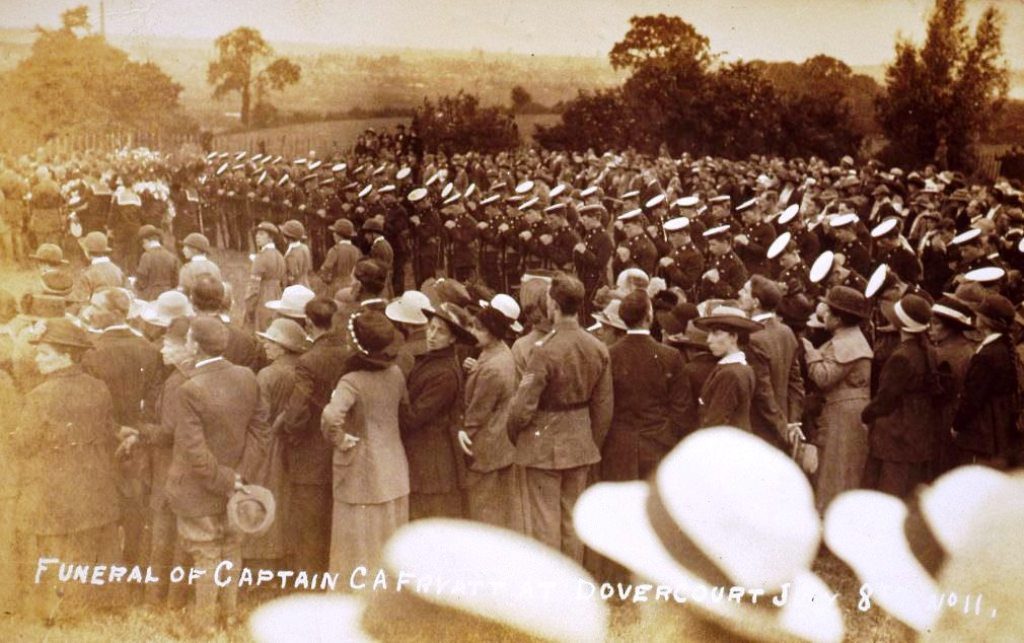
Captain Fryatt Funeral
The Execution of Capt. Charles Fryatt, following a German court-martial, provoked a storm of outrage at the time. After the war his body was exhumed and brought to England. He was subsequently buried in All Saints Churchyard on july 9th 1919. Here is how the day of the funeral was remembered: It has been retold by Mrs Jo Hart and is the recollections of her Mother Mrs Mabel Short-nee Vincent, born 1909. She recalled the occasion when as a young child after the First World War, and a pupil at the Catholic School (situated opposite Cox’s Pond) she was dressed in her Sunday best, and together with her elder sister Phoebe and brother George, they took part in the procession accompanying the funeral cortege of First world War hero Captain Fryatt who had been executed by the Germans in 1916, when his body was re-interred in All Saints churchyard, Upper Dovercourt. She and the other children were assembled at the then ‘Alexander Hotel’ on the corner of Kingsway and Marine Parade, and joined the procession behind the cortege, which had arrived for his burial by rail from London, as it made its way up to All Saints Church for the ceremony. (She believed the coffin was carried on a gun-carriage). His execution as a civilian had caused a public outcry in the country and his funeral was a sombre and awesome occasion. The local Hospital was built to his memory and was known as the Fryatt memorial Hospital. Essex Records Office.
Outdoor Swimming
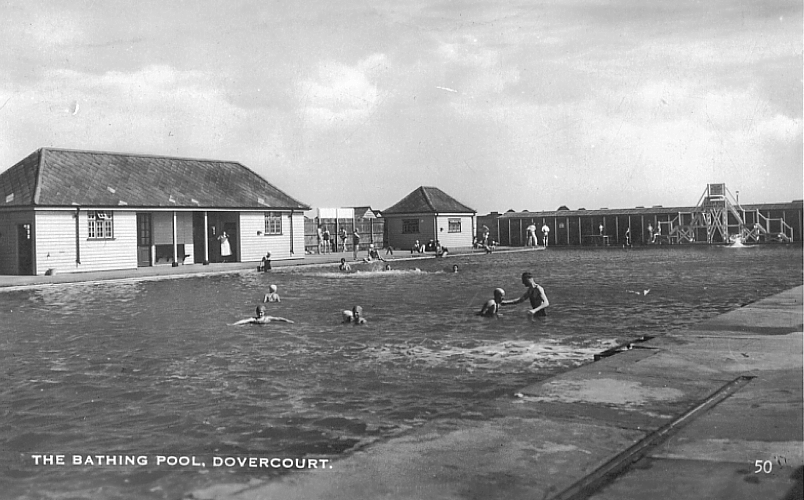
Bathing Pool
Remember it exactly like that. This was the main pool with no boards. diving pool was a round pool & i only made it off middle board. Changing rooms were concrete & outdoors! Used to spend days down there in summer! Knocked down around 1983?? Julie Odgers.
Brrrr. We had to walk from the high school, get even more cold swimming, then walk back to school frozen. I did learn to swim though. Margaret Lenton.
Omg! I remember the pool like it was yesterday. Great times swimming there in the 80’s before it was pulled down. Caroline Gunn.
GER Hotel tunnel was a route for drinks
Mrs Vincent recalled the days when as a waitress for the Great Eastern Hotel, she would pass drinks along the now bricked up tunnel to the old Quay Pavilion, across the road. The Great Eastern Hotel was licensed, but the pavilion was not, and this led to the passing of drinks under East Gate Street. “A porter would stand at the door of the pavilion, and if there was any disturbance he would ring a bell,” this warned the staff to hide the drink. Mrs Vincent.
Bathside Boys
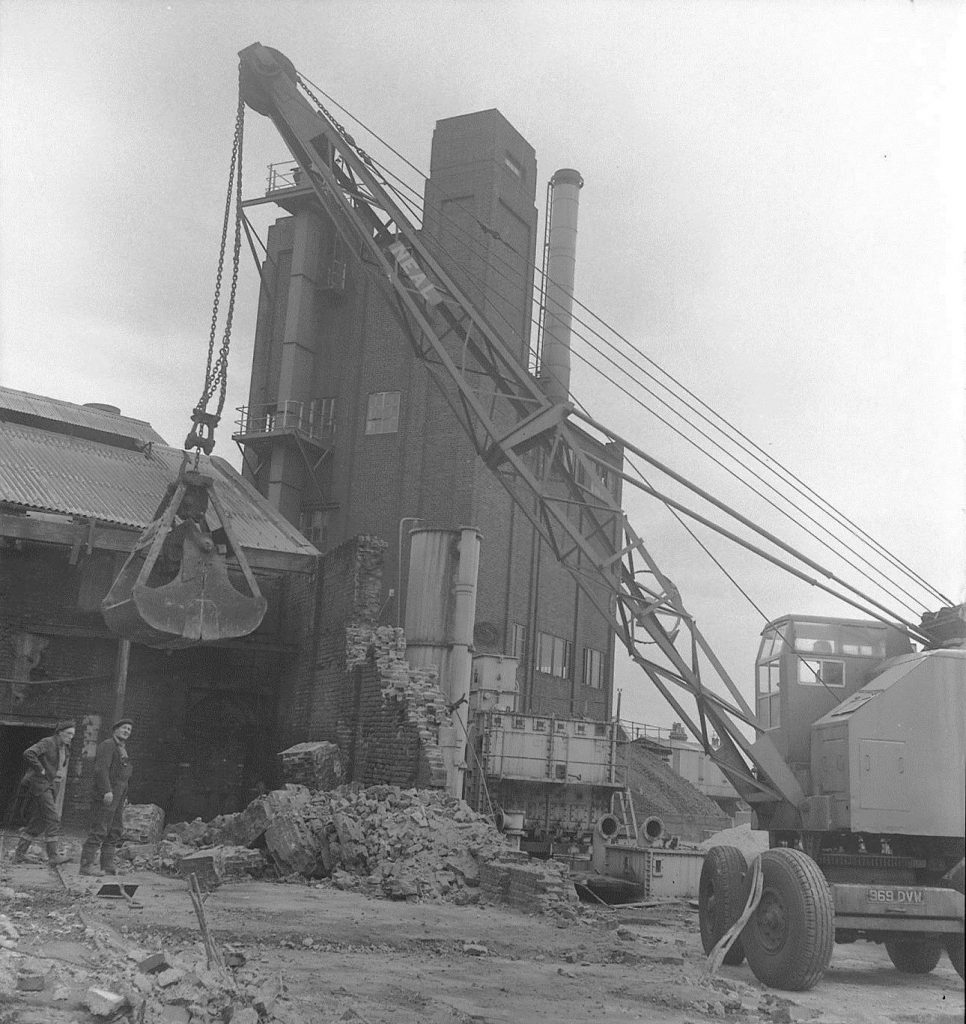
Gas Works
I was brought up at 14, Ingestre Street and always consider myself a Bathside boy. I was very lucky to have my school opposite my front door. Just up the street was Mr.Barneys shop where you could buy 4 black jacks for a halfpenny. There were sherbert flying saucers, rainbow drops – lots of sweets to keep kids happy. One end of Bathside was the railway bridge where, if you heard a train coming, you’d run to the top to disappear in clouds of smoke and steam.
At the other end of Bathside was the coke factory. Through the dirty windows men were stripped to the waist toiling away in the heat and grime. One street housed a crisp factory. Up by the park was Kettle’s soft drinks – my brother and my favourite was called Kings Cup. Along the sea wall was a scrap metal yard called Skinners. Clothes could be taken there for money by weight – wool had to be separated as you got a better price. In the summer, for a highlight of their holiday, campers at Warners in Dovercourt would walk all the way through Dovercourt and the sea wall of Bathside to go to the pub for a meal and a singalong, then walk all the way back. I still remember all of the men with knotted handkerchiefs on their heads. This was considered fun in those days and people actually enjoyed it. I will never forget when we had relatives stay and they asked us “however did we sleep at night” – we asked why, and they said the trains. This was when goods wagons were loose shunted and they had to be pushed hard to join the waggon waiting down the line. Guy Fawkes was a big thing in those days. For the princely sum of a three penny bit, those over thirteen could carry a paraffin torch in the carnival procession. A great honour then, consigned to the health and safety scrapheap probably now. Harwich harbour would host fireworks. The pier and jetty would be the backdrop of ships and tanks shooting each other in battle all done in fireworks, it was spectacular then, I don’t know what people would make of it now. Summertime was spent on Dovercourt beach when the crowds had gone home. A treat would be a trip to the cliff pavilion, an enormous lean-to conservatory with trees and plants complete with birds. In the summer there would be puppet shows and competitions for kids. Concerts were held there. My dad who was in the Harwich & Dovercourt brass band regularly played there. Best thing I liked about this was the spade and bucket shop that adjoined – sold Peters ice cream – yum yum. Such a shame when it was demolished and replaced it with what looks like the upgraded road that should have gone where the road in and out of town should be. It was a far away time, hard times, but thoroughly enjoyable. David Corley.
St.Nicholas
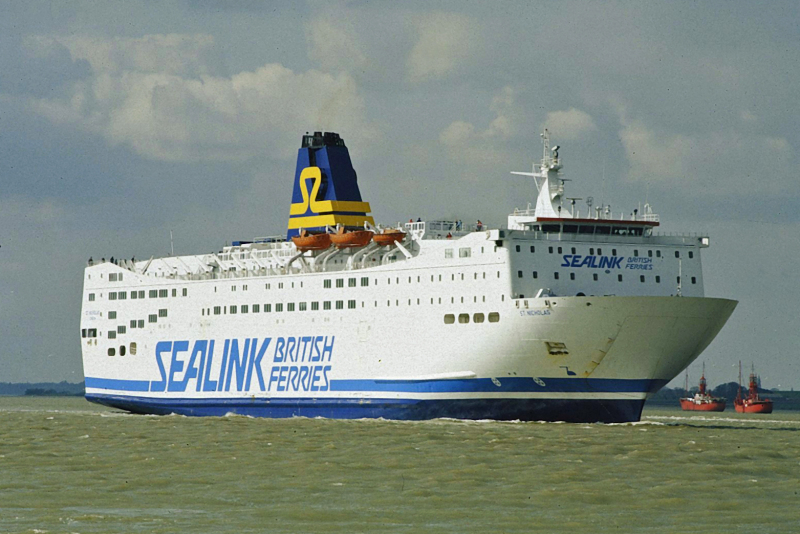
St Nicholas
(c) Derek Sands
My old ship, was a great place for an 18 yr. old lad to work, very happy times. by Gary Gorham.
My dad worked on there, used to love me free trips, remember the blue cans? I’ve got 1 reminds me of me dad x” Lisa Cardy Mckeever.
God I used to Dj on her ,, I remember being in a plastic room on deck and using loads off 2pences to keep records on the decks plus needle on records ,, great days they were lol” Andy Page.
My dad used to take me on this and wouldn’t see me for a couple of hours as the Stewardesses would spoil and make a fuss of me! And on the St Edmund too, needless to say I think I used to badger him to take me to work, we used to live in town then with no car would get so far down the road and by the time we got to Parkeston I was piggy back or on his shoulders!” by Tina.
Looked nicer after a new coat of paint! Ditto on the blue cans- they say there was a trail between Harwich and the hook, lol!” Lee Newham.
Childhood Memories
Cockles at Earlham’s, exploring West End creeks,
So many adventures in school holiday weeks
Searching for bullets in the mud from the war
Melt down for sinkers there were plenty more.
Lobsters were there, close to the drain
Sink you hand into the water if you are game.
Out in the boat to catch eels with my dad, Catch fish with no hooks, he must be mad!, Worms wrapped in wool did the trick, But you’ll only get them if you are quick!
Beach huts and deckchairs, kites in the air, Plastic sheets stretched with bamboo we really had flair!
We made them so big that they dragged us around, Down the rough grassy banks and the cricket ground.
The swimming pool was always cold; don’t know why we would go
With the temperature displayed so we would all know.
The sound of a megaphone would drift in the breeze
‘Come in number 6, your time is up please!’
The second of the lakes, when not full of weed, Saw our magnificent models travel at speed.
Some were no more than a piece of old wood, With a stick and some cardboard, but it was still good.
Miniature rail, tennis, and skating rink, Stop for an ice cream, there were so many things!
The penny arcade was open to all, It wasn’t called gambling, we just had a ball.
But there was always the beach, with those lighthouses pointing,
Over the sea where more adventure was waiting.
Part of me still walks the beach and the prom,
And I will never forget where I came from.
Chris Hart.
Parkeston Quay Memories
Oral history interview with Stan Delves on the 24th March 2016.
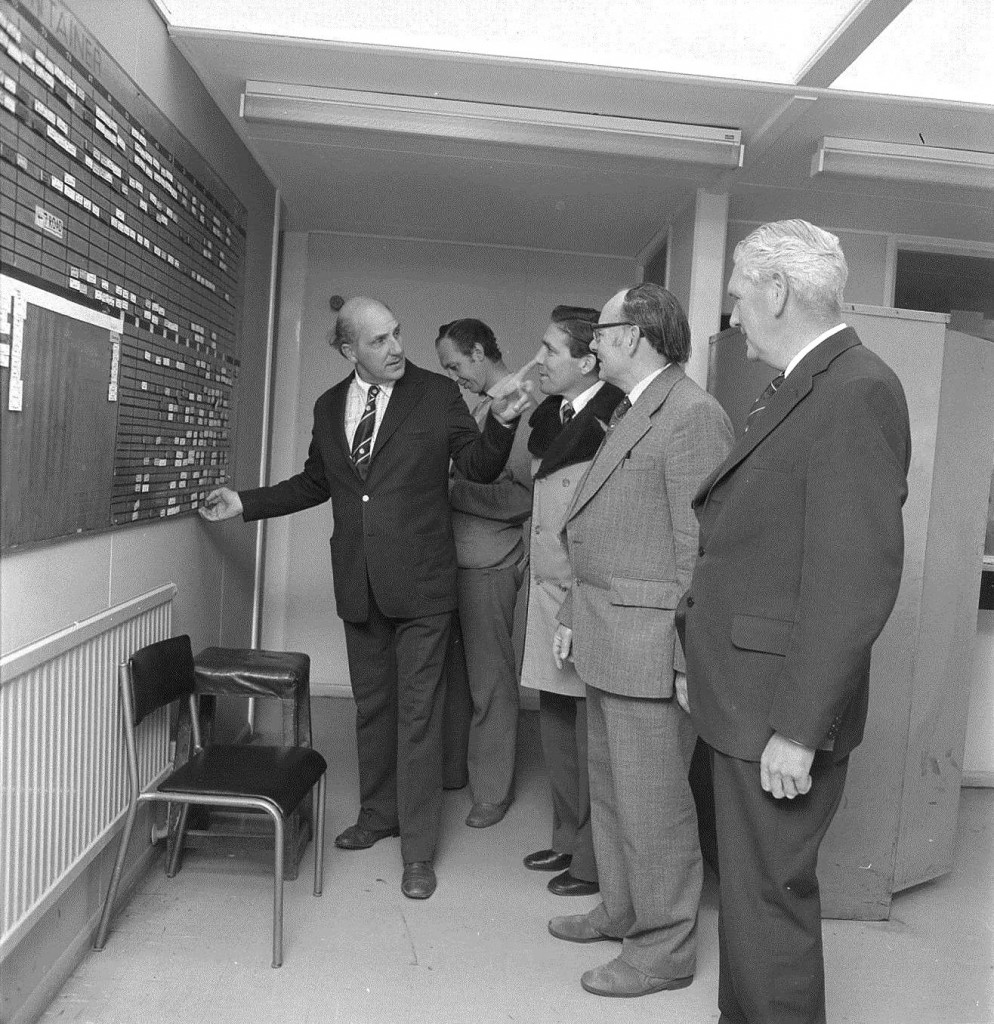
Stan’s Memories
In this interview Stan Delves talks to David Whittle, vice chairman of the Harwich Society about his memories of his time at Parkeston Quay. Born in 1930 at 41 Grafton Road, Dovercourt, I was educated at Bathside Infants and later moved to the Esplanade School and then to the Hill School, when war broke out I was evacuated to Morton near Thornbury under the care of nurse Norah Corran nicknamed “Nitty Norah”. On the 6th May 1953 I heard the news that the passenger ferry “Duke of York” had been hit by the American supply ship “Haiti victory” and the bow of the Duke of York was sliced of, I recall going to the seafront and watching the ship come around Felixstowe.
Click “play” to listen to Stan’s memories
We hope you enjoyed reading and hearing Memories from a time gone by.
We are adding more information to this site on a regular basis, if you wish to submit any photos or provide any information, please use the contact page at the bottom of the screen.
Copyright Ownership
We attempted to get the consent of copyright holders to use this material for nearly all of the photographs on the website.
In the few cases where names are available, a thorough search was made using telephone directories, photographic copyright directories, People Search and Google Area Search. None of the copyright owners could be traced in this way and we believe we have exhausted all reasonable avenues.
The consensus opinion of these authorities was that if any two of the following situations applied we would be deemed to have taken sufficient action to avoid infringing copyright laws:
- Reasonable efforts made to contact the copyright holder
- No financial gain will be made in relation to the photos
- A letter is obtained from present owner of photos
- There is a proviso included stating that if offence is caused document will be removed.
The website owner undertakes to remove any photograph from the website where offence is caused. All the above conditions have therefore been met.
Acknowledgements: Essex Record Office, The Harwich Society.
